Motorola Solutions 92FT4859 Mobile and Base Station Transmitter User Manual CDM1250 Mobile Radio User Guide
Motorola Solutions, Inc. Mobile and Base Station Transmitter CDM1250 Mobile Radio User Guide
Contents
- 1. Exhibit D Users Manual per 2 1033 c3
- 2. RF Safety Manual
Exhibit D Users Manual per 2 1033 c3

i
English
CONTENTS
CONTENTS
Computer Software Copyrights . . . . . . . . . . . .ii
Safety . . . . . . . . . . . . . . . . . . . . . . . . . . . . . . 1
Product Safety and RF Exposure
Compliance . . . . . . . . . . . . . . . . . . . . . . . . . 1
Radio Overview . . . . . . . . . . . . . . . . . . . . . . 3
Parts of the Radio . . . . . . . . . . . . . . . . . . . . . 3
Optional Enhanced Keypad Microphone
(RMN4026) . . . . . . . . . . . . . . . . . . . . . . . 4
On/Off/Volume Knob . . . . . . . . . . . . . . . . 5
Channel Selector Buttons . . . . . . . . . . . . 5
LED Indicators . . . . . . . . . . . . . . . . . . . . . 5
Programmable Buttons . . . . . . . . . . . . . . 5
Push-to-Talk (PTT) Button . . . . . . . . . . . . 8
Microphone . . . . . . . . . . . . . . . . . . . . . . . 8
Use with Enhanced Keypad Microphone
(RMN4026) . . . . . . . . . . . . . . . . . . . . . . . 8
LCD Screen . . . . . . . . . . . . . . . . . . . . . . . 8
Audio Indicators for Programmable Buttons 10
Getting Started . . . . . . . . . . . . . . . . . . . . . 11
Turning the Radio On or Off . . . . . . . . . . . . 11
Adjusting the Volume . . . . . . . . . . . . . . . . . 11
Selecting a Zone . . . . . . . . . . . . . . . . . . . . . 12
Selecting a Radio Channel . . . . . . . . . . . . . 12
Sending a Call . . . . . . . . . . . . . . . . . . . . . . .13
Receiving a Call . . . . . . . . . . . . . . . . . . . . . .13
Radio Calls . . . . . . . . . . . . . . . . . . . . . . . . .15
Making a Selective Call . . . . . . . . . . . . . . . .15
Receiving a Selective Call F. . . . . . . . . . . . .16
Sending a Call Alert™ Page. . . . . . . . . . . . .16
Receiving a Call Alert Page . . . . . . . . . . . . .17
Radio Check . . . . . . . . . . . . . . . . . . . . . . . . .19
responding to emergency
alerts E . . . . . . . . . . . . . . . . . . . . . . . . . . . .21
Decoding an Emergency Alarm. . . . . . . .21
Multiple Queued Emergencies . . . . . . . .22
Three Minute Timer . . . . . . . . . . . . . . . . .22
After the Timer Expires . . . . . . . . . . . . . .22
Clearing an Emergency
Alert E . . . . . . . . . . . . . . . . . . . . . . . . . . . . .23
Sending an Emergency Remote Monitor . . .23
Sending an Emergency Alert E . . . . . . . . . .24
Selective Radio Inhibit . . . . . . . . . . . . . . . . .24
Repeater or Talkaround J Mode. . . . . . . . .24
Setting the Power Level B . . . . . . . . . . . . . .25
Name and Call Tone Tagging. . . . . . . . . . . .26
Scan . . . . . . . . . . . . . . . . . . . . . . . . . . . . . . .29
Starting or Stopping Scan G. . . . . . . . . . . . .29
Talkback . . . . . . . . . . . . . . . . . . . . . . . . . . . .30
Deleting a Nuisance Channel . . . . . . . . . . . .30

ii
English
CONTENTS
Restoring a Channel to the Scan List . . .30
Editing a Scan List . . . . . . . . . . . . . . . . . . . .30
Adding or Deleting Channels in a Scan List
31
Prioritizing a Channel in a Scan List . . . .32
Setting Priority Channels . . . . . . . . . . . . .32
Phone. . . . . . . . . . . . . . . . . . . . . . . . . . . . . .35
Making a Phone Call D. . . . . . . . . . . . . . . . .35
Audio/Tone Settings. . . . . . . . . . . . . . . . . .37
Utilities. . . . . . . . . . . . . . . . . . . . . . . . . . . . .39
Selecting the Display Language . . . . . . . . . .40
Warranty . . . . . . . . . . . . . . . . . . . . . . . . . . .41
Limited Warranty. . . . . . . . . . . . . . . . . . . . . .41
Accessories . . . . . . . . . . . . . . . . . . . . . . . .45
Audio . . . . . . . . . . . . . . . . . . . . . . . . . . . . . .45
Mounting. . . . . . . . . . . . . . . . . . . . . . . . . . . .45
Antennas . . . . . . . . . . . . . . . . . . . . . . . . . . .46
Control Station . . . . . . . . . . . . . . . . . . . . . . .46
COMPUTER SOFTWARE
COPYRIGHTS
The Motorola products described in this
manual may include copyrighted Motorola
computer programs stored in semiconductor
memories or other media. Laws in the United
States and other countries preserve for
Motorola certain exclusive rights for
copyrighted computer programs including, but
not limited to, the exclusive right to copy or
reproduce in any form the copyrighted
computer program. Accordingly, any
copyrighted Motorola computer programs
contained in the Motorola products described
in this manual may not be copied, reproduced,
modified, reverse-engineered, or distributed in
any manner without the express written
permission of Motorola. Furthermore, the
purchase of Motorola products shall not be
deemed to grant either directly or by
implication, estoppel, or otherwise, any license
under the copyrights, patents or patent
applications of Motorola, except for the normal
non-exclusive license to use that arises by
operation of law in the sale of a product.

1
English
SAFETY
SAFETY
PRODUCT SAFETY AND RF
EXPOSURE COMPLIANCE
ATTENTION!
This radio is restricted to occupational use
only to satisfy FCC RF energy exposure
requirements. Before using this product, read
the RF energy awareness information and
operating instructions in the Product Safety
and RF Exposure booklet enclosed with your
radio to ensure compliance with RF energy
exposure limits.
For a list of Motorola-approved antennas,
batteries, and other accessories, visit the
following web site which lists approved
accessories: http://www.motorola.com/cgiss/
index.shtml.
Before using this product, read
the operating instructions for safe
usage contained in the Product
Safety and RF Exposure booklet
enclosed with your radio.
!
C
a u t i o
n

2
English
SAFETY
Notes
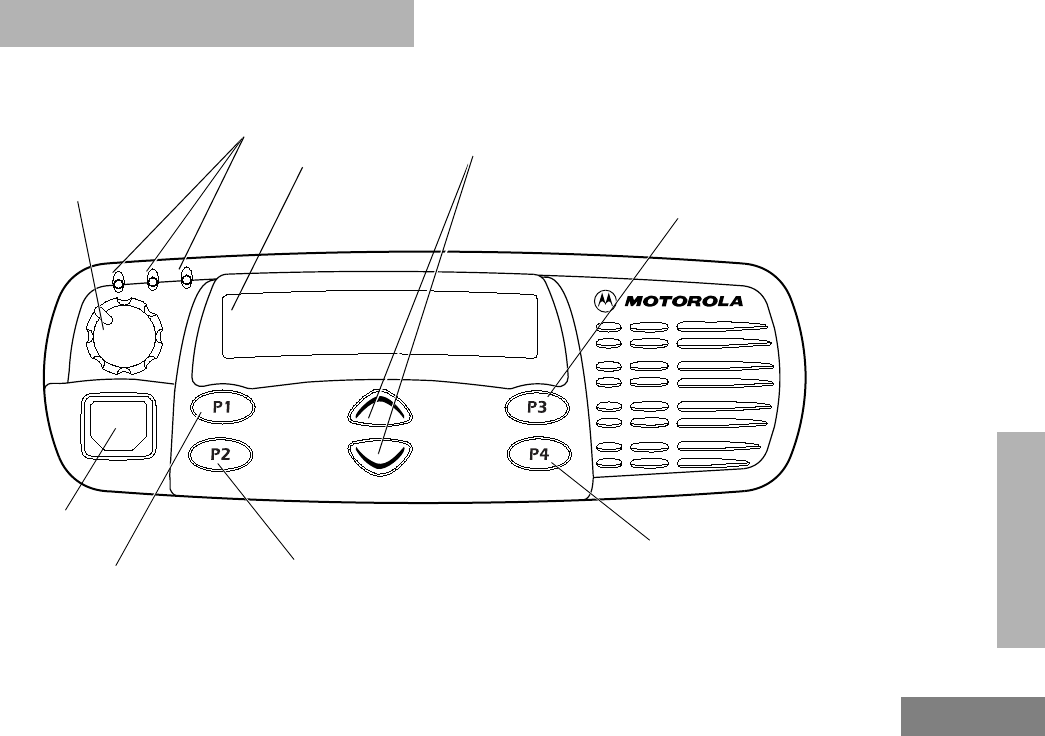
3
English
RADIO OVERVIEW
RADIO OVERVIEW
PARTS OF THE RADIO
MAEPF-26782-O
(Interchangeable)
Programmable
Button 2 (P2) (Interchangeable)
Programmable
Button 4 (P4)
(Interchangeable)
Programmable
Button 3 (P3)
Red/Yellow/Green
LED Indicators
(Interchangeable)
Programmable
Button 1 (P1)
Microphone
-DFN
Knob
On/Off/Volume
Channel Selector
(Up/Down)
LCD Screen
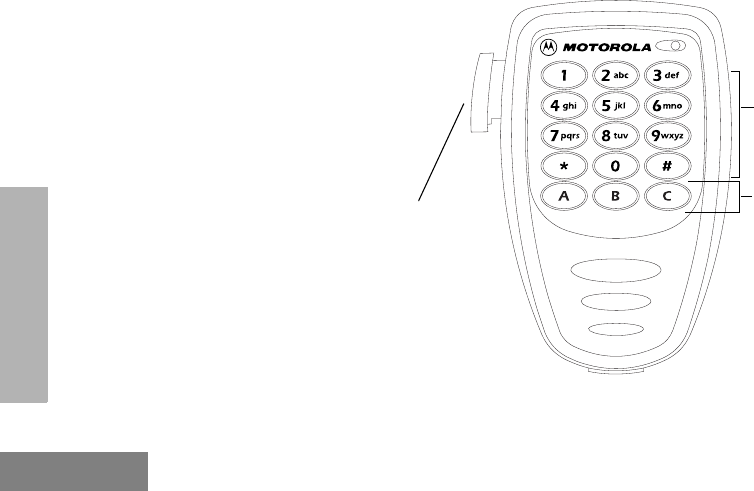
4
English
RADIO OVERVIEW
Optional Enhanced Keypad Microphone
(RMN4026)
Your radio may be ordered with an optional
DTMF (Dual-Tone Multi-Frequency)
microphone that has a direct entry keypad.
This enhanced keypad microphone has three
buttons (A, B, C) below the keypad that can be
programmed to conveniently activate select
radio features.
By purchasing this enhanced keypad
microphone, you will be able to gain access to
menu capabilities and the radio’s user-
selectable features.
FL0830328O
Keypad
Push-to-Talk
(PTT) button
Programmable
Buttons
(A, B, C)

5
English
RADIO OVERVIEW
On/Off/Volume Knob
Turns the radio on or off, and adjusts the
radio’s volume.
Channel Selector Buttons
Used for channel scrolling.
LED Indicators
Indicates channel, scan, and monitor status, as
well as receipt of a selective call.
Programmable Buttons
Your radio has several programmable buttons.
Your dealer can program these buttons as
shortcuts to various radio features.
Check with your dealer for a complete list of
functions your radio supports.
Programmable buttons include the g, h,
i, and j buttons (see page 3).
Some buttons can access up to two features,
depending on the type of button press:
• short press—quickly pressing and releasing
the programmable buttons
• long press—pressing and holding the
programmable buttons for a period of time
(default 1 1/2 seconds or programmed
value)
• hold down—pressing and holding down the
programmable buttons while checking
status or making adjustments
A summary of programmable radio features
and corresponding page references appears
beginning on page 6.
In the “Button” column, have your dealer
record the name of the programmable button
next to the feature that has been programmed
to it.
The dealer can use the abbreviations (P1, P2,
P3, P4) shown in the radio illustration on
page 3.
Also, where appropriate, have your dealer
indicate whether the button press requires a
short press, a long press, or needs to be held
y or z

6
English
RADIO OVERVIEW
down.
Function Indicator Short Press Long Press Hold Down Page Button
Volume Set — — —
Sound a tone
for adjusting
your radio’s
volume level.
11
Home Revert — Takes you directly to a preprogrammed
zone/channel combination.†—12
Direct Zone
Access — Direct entry to zone selection menu.† —12
Direct Channel
Access —Direct entry to channel selection.†
(Enhanced keypad microphone required.) —13
PRTT (Priority
Request-to-Talk) —Sends a priority access
request to the dispatcher. —13
Emergency EInitiate Emergency Alert. Cancel
Emergency
status. —21
Repeater/
Talkaround JToggle between using a repeater or
transmitting directly to another radio.†—24
Power Level BToggle transmit power level between High
and Low.†—25
Scan/Nuisance
Channel Delete GToggle scan on and off.
Delete a
nuisance
channel while
scanning.
—29
Phone DAccess Phone Mode.†—35
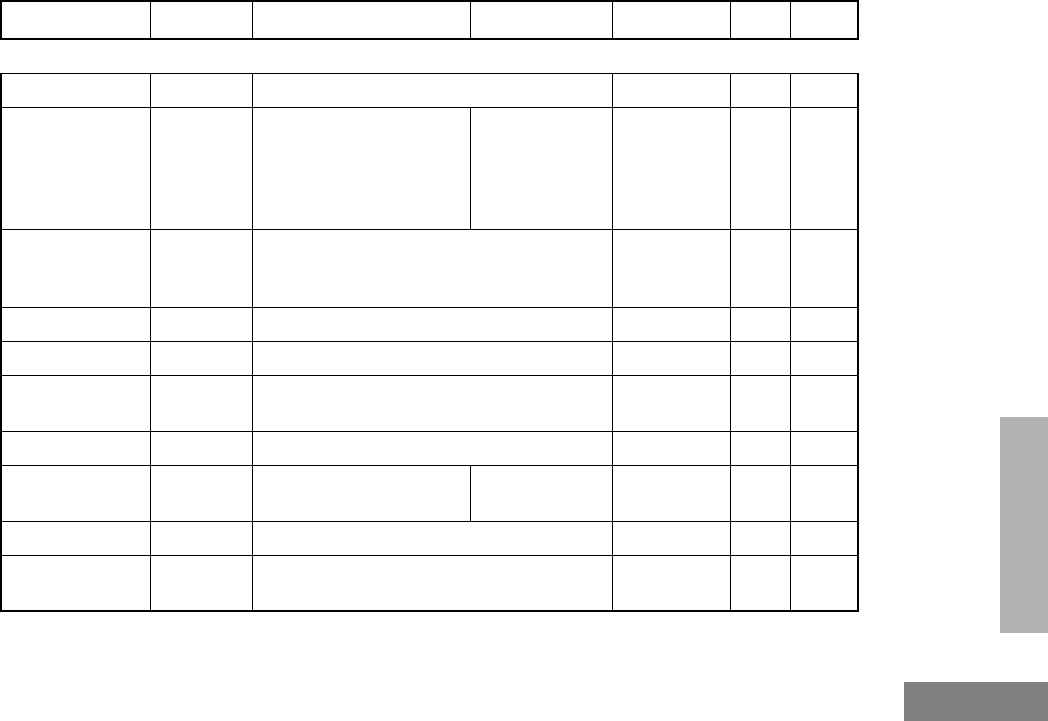
7
English
RADIO OVERVIEW
† This function is activated by EITHER a short OR a long press, but not both.
Speed Dial — Access your phone list directly.†—36
Monitor C
Toggle silent monitor
operation (also turn off
open squelch monitor
when it has been
activated).
Turn on open
squelch
monitor. ——
Option Board
(if one is
installed)
NToggle between activating and deactivating
the option board.†——
Radio Call — Access the radio call menu.†——
Light — Adjust brightness level (off/low/med/high).†——
Auxiliary
Control (1/2) —Activate or deactivate a pin on the
accessory connector.† (See your dealer.) ——
Menu/Enter Enter the menu or confirm selection.†——
Exit Step one level back in the
menu. Exit the menu. ——
Up/Down Step through menu choices. ——
Horn and Lights — Toggle external alarm feature or cancels a
triggered alarm.†——
† This function is activated by EITHER a short OR a long press, but not both.
Function Indicator Short Press Long Press Hold Down Page Button
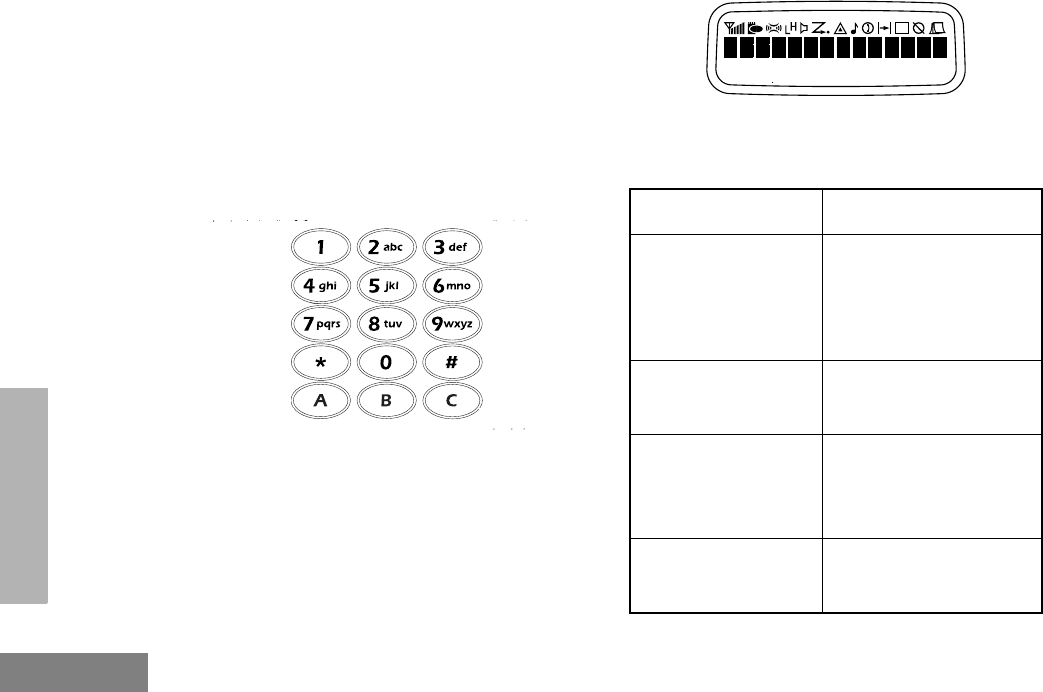
8
English
RADIO OVERVIEW
Push-to-Talk (PTT) Button
Press and hold down this button to talk;
release it to listen.
Microphone
Hold the microphone 1 to 2 inches (2.5 to
5 cm) from your mouth, and speak clearly
into it.
Use with Enhanced Keypad Microphone
(RMN4026)
These keys are used to:
• Dial a phone number
• Make a radio call
• Directly access preprogrammed features
LCD Screen
The top screen row displays radio status
information:
A B C
Symbol Indication
A
Companding
The Companding
feature is activated.
When in narrow band,
this feature improves
audio quality.
B
Power Level
Low Power “ R” or High
Power “ S “ is activated.
C
Carrier Squelch
(CSQ)
The radio is on a CSQ
channel, monitor is
active, or the
microphone is off-hook.
D
Phone
Phone Mode is
selected.
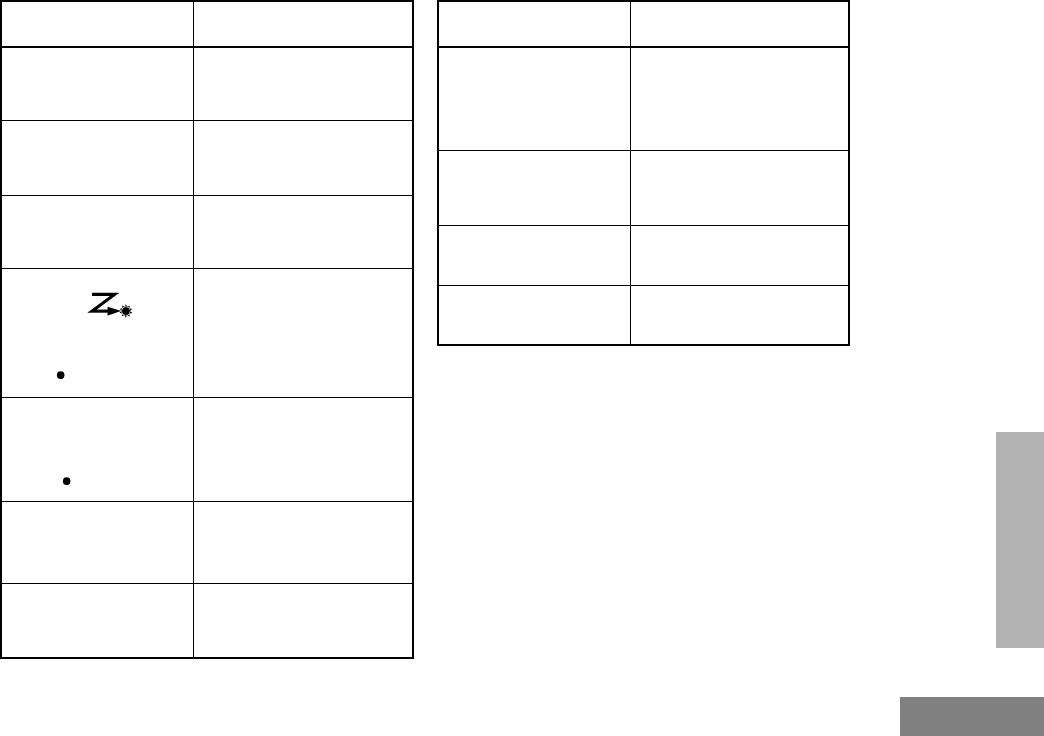
9
English
RADIO OVERVIEW
E
Emergency
An Emergency Alert is
being sent.
F
Call Received
A Selective Call or Call
Alert has been received.
G
Scan
The Scan feature is
active.
Priority 1 Scan
( flashing)
During Scan, indicates
that the scan has locked
on to a priority 1
channel.
H
Priority 2 Scan
( steady)
During Scan, indicates
that the scan has locked
on to a priority 2
channel.
J
Talkaround
The radio is not
transmitting through a
repeater.
K
Programming Mode
The radio is in Program
List editing mode.
Symbol Indication
M
Signal Strength
Indicates signal
strength. The more
bars, the stronger the
signal.
N
Option Board
Option board is enabled.
QNot currently
assigned.
LNot currently
assigned.
Symbol Indication
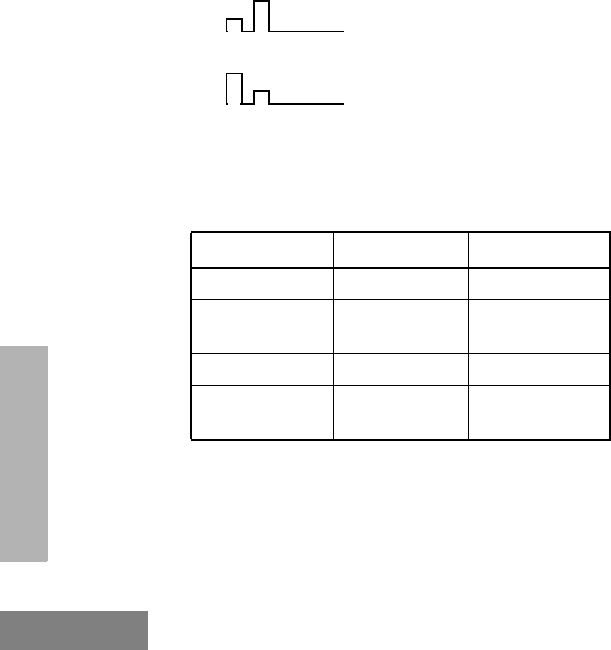
10
English
RADIO OVERVIEW
AUDIO INDICATORS FOR
PROGRAMMABLE BUTTONS
In addition to having associated visual
indicators, some programmable buttons use
tones to indicate one of two modes:
Low-High Tone
High-Low Tone
Button Low-High Tone High-Low Tone
Scan Start scan Stop scan
Power Level High power
selected Low power
selected
Option Board Enabled Disabled
Repeater/
Talkaround Does not use
repeater Uses repeater
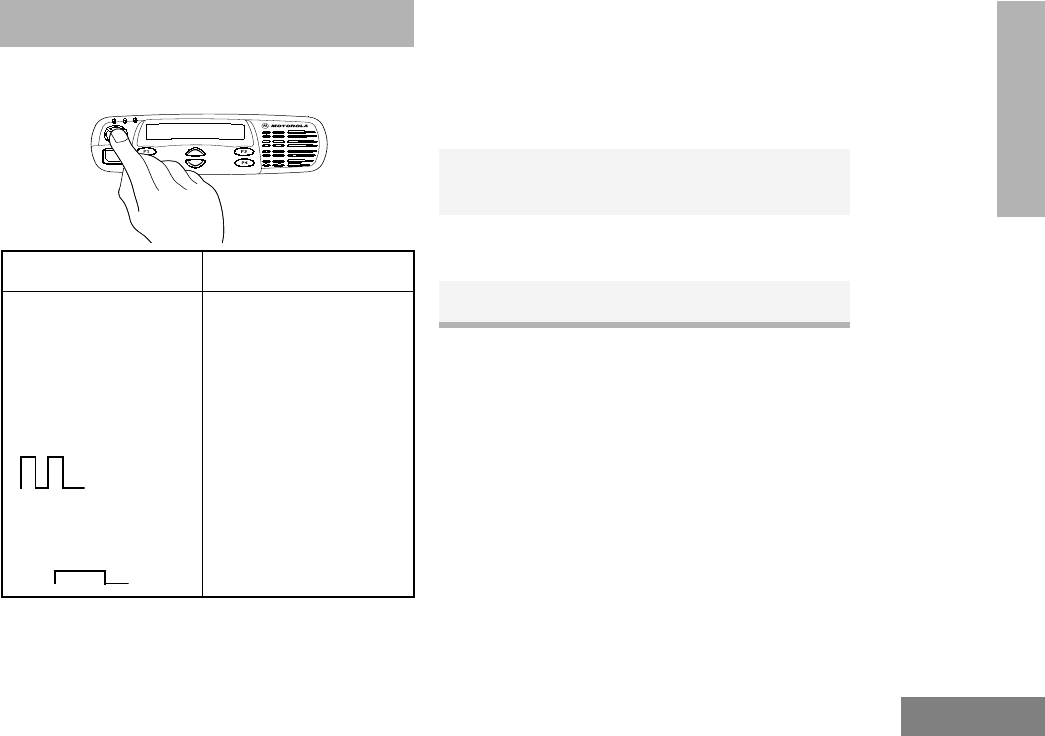
11
English
GETTING STARTED
GETTING STARTED
TURNING THE RADIO ON OR OFF
ADJUSTING THE VOLUME
Turn the On/Off/Volume Control knob
clockwise to increase the volume, or
counterclockwise to decrease the volume.
–or–
ON OFF
Push the On/Off/
Volume Control knob
until you hear a click.
If power-up is
successful, you will
hear the Self-Test Pass
Tone (if programmed)
.
If the radio fails to
power up, you will hear
the Self-Test Fail
Tone .
Push the On/Off/
Volume Control knob
until you hear a click and
the display clears.
1Hold down the Volume Set button (see
page 6). You will hear a continuous tone.
2Turn the On/Off/Volume Control knob to the
desired volume level.
3Release the Volume Set button.
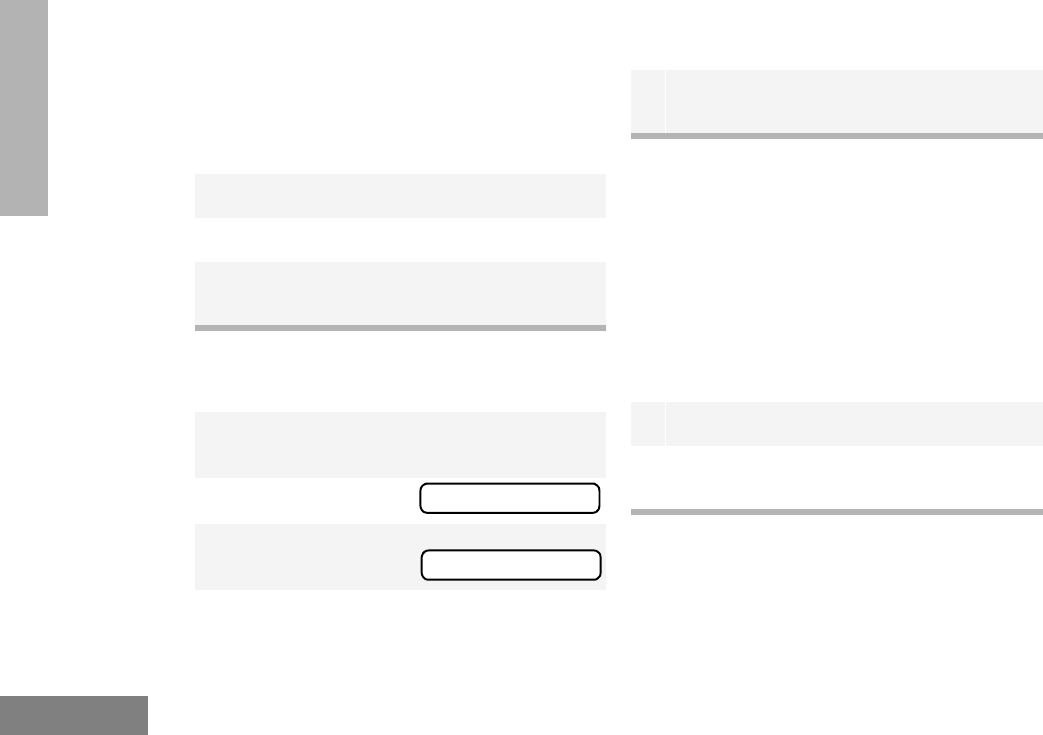
12
English
GETTING STARTED
SELECTING A ZONE
A zone is a group of up to 16 channels. Before
you can access a channel in a zone, you must
select the zone in one of two ways:
Method 1 (if programmed by your dealer [see
pages 6 - 7])
Method 2 (enhanced keypad microphone
required)
SELECTING A RADIO CHANNEL
Your radio offers 64 channels (4 zones of 16
channels each).
Note: Due to government regulations, some
channels may not be programmed.
See your dealer for more information.
There are three ways to select a channel:
Method 1
Method 2 (if programmed by your dealer [see
pages 6 - 7])
Press the Home Revert button.
1Press the Direct Zone Access button.
2y or z until you reach the desired zone.
3Press the Direct Zone Access button to
select the zone.
1Press the Menu/Enter button to enter Menu
Mode.
2y or z until
3Press the Menu/
Enter button to select
Zone
Zone
4y or z until you see the desired zone
name.
5Press the Menu/Enter button to select the
zone.
1Select the appropriate Zone, if required.
2y or z until you reach the desired
channel, shown on the LCD display.

13
English
GETTING STARTED
Method 3 (if programmed by your dealer [see
pages 6 - 7]. Enhanced keypad microphone
required.)
SENDING A CALL
If your system uses the request-to-talk feature,
use the following method to send a call:
RECEIVING A CALL
1Press the Direct Channel Access button.
2Enter the desired channel using the enhanced
keypad microphone.
3Press the Direct Channel Access button to
confirm your selection.
1Turn your radio on.
2y or z to select the desired channel.
3Hold the microphone vertically 1 to 2 inches
(2.5 to 5 cm) from your mouth. Press the PTT
to talk; release it to listen.
1Turn your radio on.
2y or z to select the desired channel.
3Press the PTT (for priority requests to talk, the
PRTT) button and wait for the talk permit tone.
4Hold the microphone vertically 1 to 2 inches
(2.5 to 5 cm) from your mouth. Press the PTT
to talk; release it to listen.
1Turn your radio on.
2Adjust the radio’s volume, if necessary (see
page 11).
3Select the desired channel.
4To respond, hold the microphone vertically 1
to 2 inches (2.5 to 5 cm) from your mouth.
Press the PTT to respond to an incoming call;
release it to listen.

14
English
GETTING STARTED
Notes
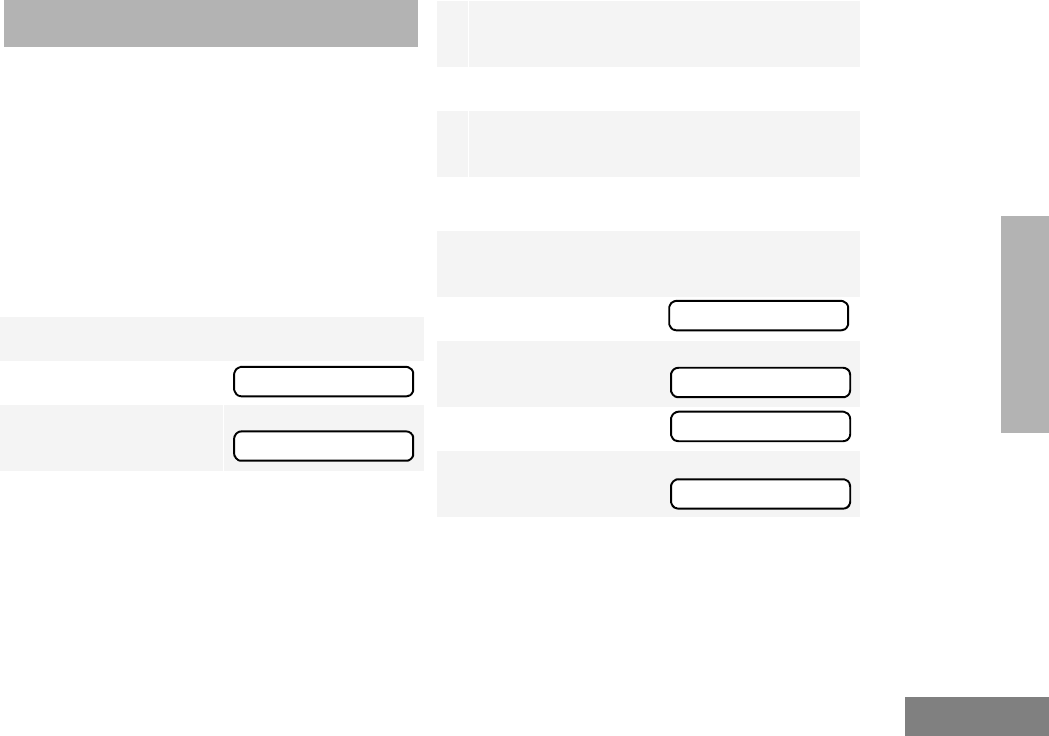
15
English
RADIO CALLS
RADIO CALLS
MAKING A SELECTIVE CALL
You can make a selective call to a particular radio
or group of radios, provided the signalling
protocol supports it.
Note: An enhanced keypad microphone is
required to operate this feature.
To make a Selective Call:
Method 1
Method 2
1
Press the
Radio Call
button to enter Menu mode.
2y or z until
3Press the Radio Call
button to select
4y or z to locate the desired ID in the
Radio Call list;
–or–
using the enhanced keypad microphone, enter
the ID number of the radio you want to call.
Selective Call
Selective Call
5Press the PTT to send the call. The radio
sounds a continuous tone.
6Press the PTT to talk; release it to listen.
7When finished with the call, press the Radio
Call button to exit.
1
Press the
Menu/Enter
button to enter Menu
Mode.
2y or z until
3Press the Menu/
Enter button to select
4y or z until
5Press the Menu/
Enter button to select
Radio Call
Radio Call
Selective Call
Selective Call
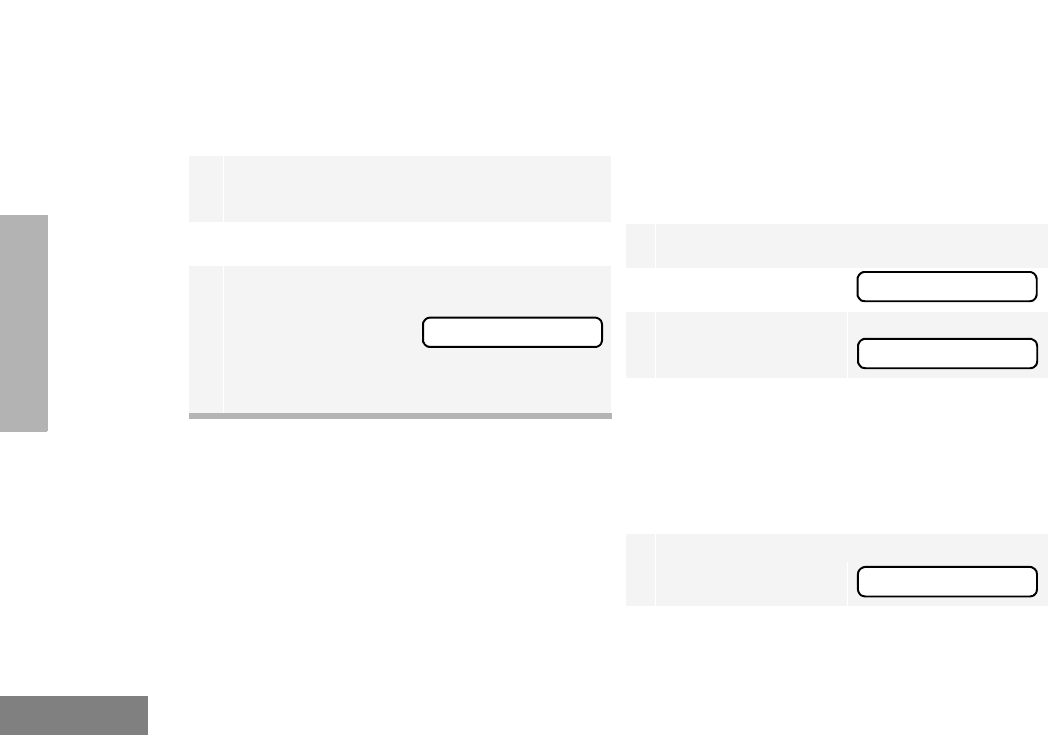
16
English
RADIO CALLS
RECEIVING A SELECTIVE CALL F
When you receive a selective call:
• You will hear two alert tones.
• The yellow LED Indicator flashes.
• The LCD screen displays F and the
preprogrammed name or ID of the calling
radio, if available.
SENDING A CALL ALERT™ PAGE
You can alert another person by sending a Call
Alert page.
Note: An enhanced keypad microphone is
required to operate this feature.
To send a Call Alert page:
Method 1
6y or z to locate the desired ID in the
Radio Call List;
–or–
using the enhanced keypad microphone, enter
the ID number of the radio you want to call.
7Press the PTT to send the call. The radio
sounds a continuous tone.
8Press the PTT to talk; release it to listen.
9When finished with the call,
press the Exit button
to return to
–or–
Hold down the Exit button to exit Menu Mode.
Selective Call
1
Press the
Radio Call
button to enter Menu Mode.
2y or z until
3Press the Radio Call
button to select
4y or z to locate the desired ID in the
Radio Call list;
–or–
using the enhanced keypad microphone, enter
the ID number of the radio you want to page.
5Press the PTT to send the page.
You will see
6If the Call Alert page is received,
Call Alert
Call Alert
Call In Prog
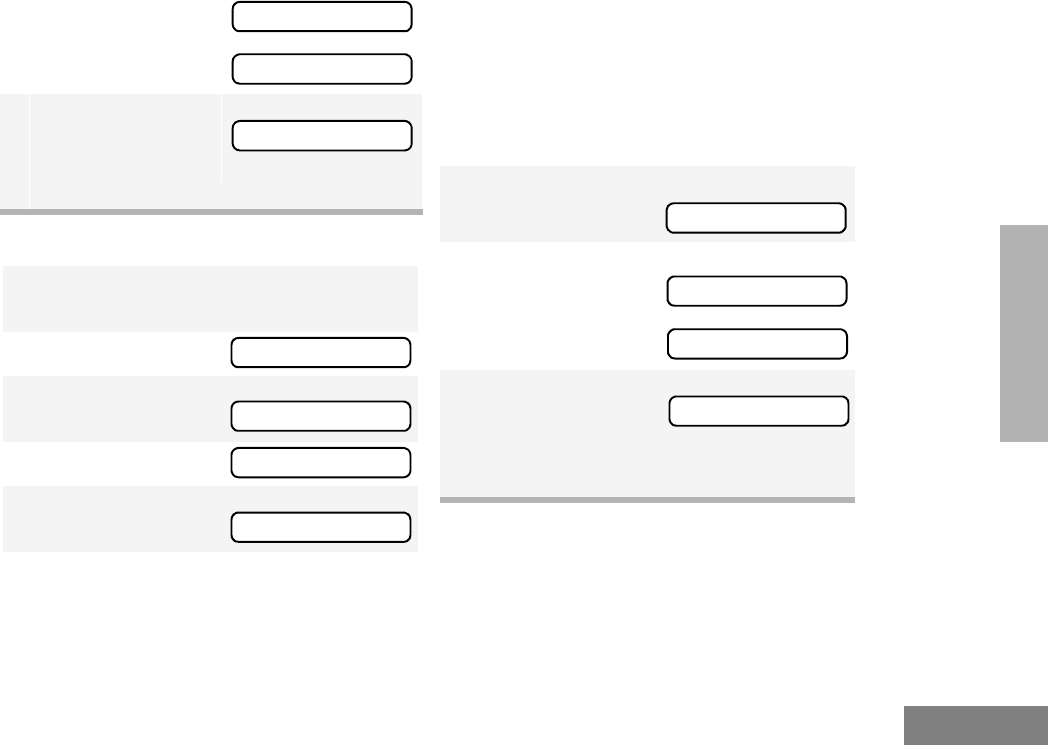
17
English
RADIO CALLS
Method 2
RECEIVING A CALL ALERT PAGE
When your radio receives a Call Alert page, it
sounds four alert tones continuously and the
following are displayed until you respond:
you will see
If not,
you will see
7Press the Exit button
to return to
–or–
Hold down the Exit button to exit Menu Mode.
1
Press the
Menu/Enter
button to enter Menu
Mode.
2y or z until
3Press the Menu/
Enter button to select
4y or z until
5Press the Menu/
Enter button to select
Acknowledge
No Acknowledge
Call Alert
Radio Call
Radio Call
Call Alert
Call Alert
6y or z to locate the desired ID in the
Radio Call List;
–or–
using the enhanced keypad microphone, enter
the ID number of the radio you want to page.
7Press the PTT to send the page.
You will see
8If the Call Alert page is received,
you will see
If not,
you will see
9Press the Exit button
to return to
–or–
Hold down the Exit button to exit Menu Mode.
Call In Prog
Acknowledge
No Acknowledge
Call Alert

18
English
RADIO CALLS
the F symbol, and the ID of the calling radio
alternating with .
Press the PTT to answer the page, or press
any other key to clear it.
Note: Your radio will display only the last Call
Alert page received. Also, your radio
will not receive any Selective Calls until
you clear the page.
Call Received
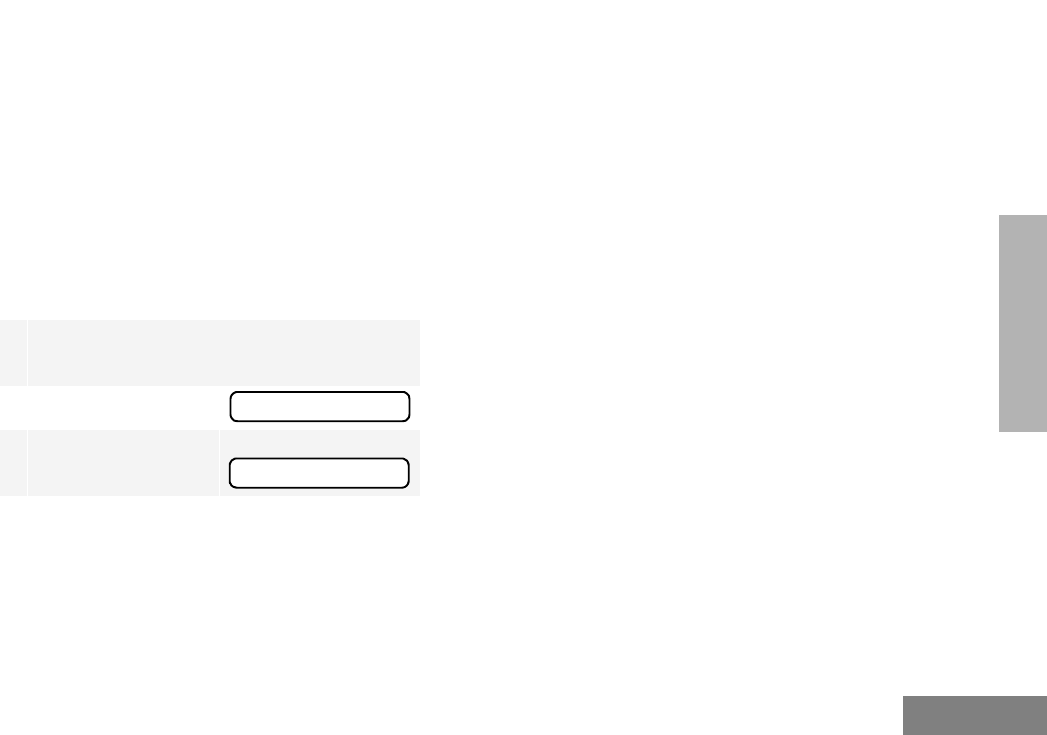
19
English
RADIO CALLS
RADIO CHECK
This feature allows you to determine if a radio
is in range without disturbing the user of the
radio. Radio Check can also be used when
attempts with Selective Call and Call Alert fail.
(This feature is available only if your signalling
protocol supports it.)
Note: An enhanced keypad microphone is
required to operate this feature.
To perform a Radio Check:
Method 1
1
Press the
Radio Call
button
(if programmed)
t
o enter the Radio Call menu.
2y or z until
3Press the Radio Call
button to select
Radio Check
Radio Check
4y or z to locate the desired ID in the
Radio Call List;
–or–
using the enhanced keypad microphone, enter
the ID number of the radio you wish to check.
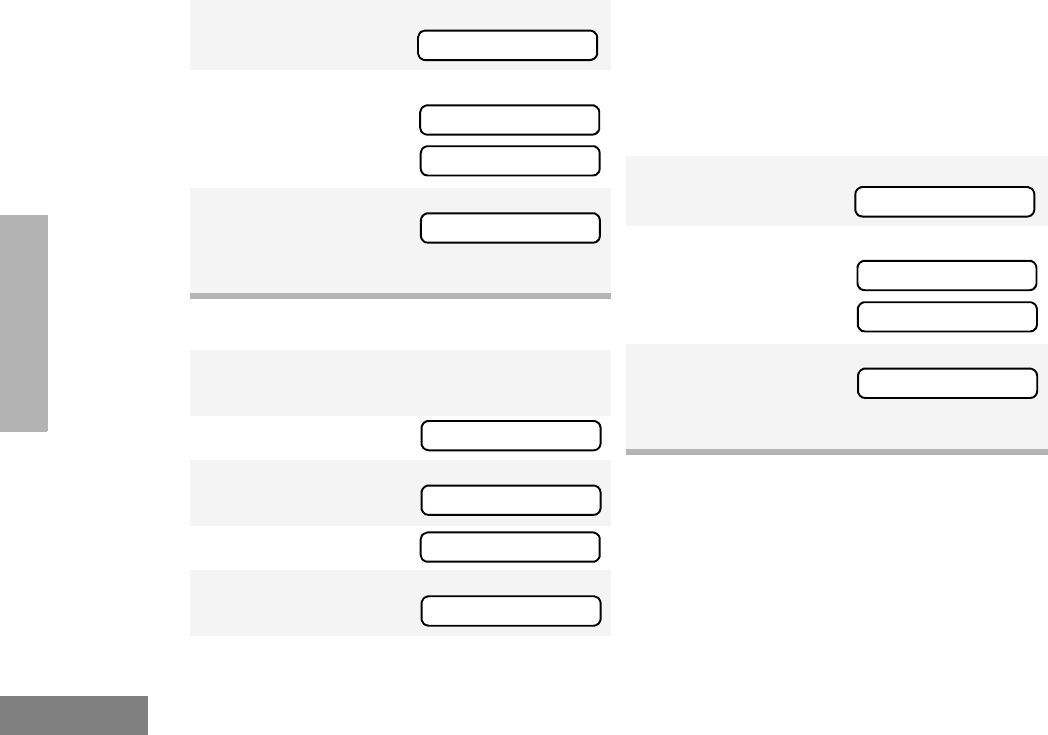
20
English
RADIO CALLS
Method 2
5Press the PTT.
You will see
6If the Radio Check is received,
you will see
If not, you will see
7Press the Exit button
to return to
–or–
Hold down the Exit button to exit Menu Mode.
1
Press the
Menu/Enter
button to enter Menu
Mode.
2y or z until
3Press the Menu/Enter
button to select
4y or z until
5Press the Menu/Enter
button to select
Call In Prog
Acknowledge
No Acknowledge
Radio Check
Radio Call
Radio Call
Radio Check
Radio Check
6y or z to locate the desired ID in the
Radio Call List;
–or–
using the enhanced keypad microphone, enter
the ID number of the radio you wish to check.
7Press the PTT.
You will see
8If the Radio Check is received,
you will see
If not, you will see
9Press the Exit button
to return to
–or–
Hold down the Exit button to exit Menu Mode.
Call In Prog
Acknowledge
No Acknowledge
Radio Check

21
English
RADIO CALLS
RESPONDING TO EMERGENCY
ALERTS (
Your radio offers choices for initiating and
responding to Emergency Alert
communications. Choices may include:
• Emergency Cycles - Allows the radio to
automatically cycle between transmit and
receive mode over a preprogrammed
number of times by keying with voice after it
has received an Acknowledge to the alarm
you send. The default number of transmits
is one (10, maximum); the default value of
the retransmit interval is 5 seconds (one,
minimum; 60, maximum).
• Emergency Alarm/Call - Gives you access
to a voice resource, on a priority basis, over
all other types of call traffic.
• Emergency Remote Monitor - Enables the
dispatcher to activate the transmit circuit of
your radio, during an Emergency, to hear
the situation through your microphone. See
page 23 for more about sending an
Emergency Remote Monitor.
• Remote Monitor - Enables the dispatcher to
activate the transmit circuit of your radio,
during a normal dispatch, to hear the
situation through your microphone. See
page 23 for information about sending a
Remote Monitor.
Note: All the choices listed above are dealer
preprogrammed. See your dealer for
more details.
Decoding an Emergency Alarm
If preprogrammed by your dealer, and provided
the signaling protocol supports it, your radio
decodes (responds to) an Emergency Alarm or
Emergency Call by:
• Sounding a unique, repeating alert tone
• Activating an external alarm
• Displaying alternating message parts on a
single line, similar to the following example
Eme rg enc y
E

22
English
RADIO CALLS
■the word Emergency, followed by
■Emergency Alias from the Radio
Call List (example, MDC CALL 01),
followed by
■ Timestamp of the Emergency
Alert (example, 03:55).
• Flashing the E icon (while decoding only;
lights steady when encoding)
Multiple Queued Emergencies
Clearing the existing displayed Emergency
shows the next in the queue, if one exists.The
display updates and shows “Emerg (queued
number) of (total number)”. If no additional
Emergencies are queued, the radio exits
Emergency mode and resumes normal mode.
Three Minute Timer
Responding to an Emergency starts a three-
minute timer. The radio does not generate
another Emergency Alert tone against that
Emergency Alias or ID until the three-minute
period expires. If cleared within 3 minutes, the
alarm will regenerate the alert. If the radio
receives another Emergency Alert from the
same Alias or ID, the radio acknowledges the
Emergency but does not restart the tone,
activate the external alarm, or display updated
information.
After the Timer Expires
If the three-minute timer has expired for a
specific Emergency Alias or ID, and the radio
decodes an Emergency that is currently in
queue, the radio:
• Acknowledges the Emergency
• Restarts the Emergency Alert tone
• Activates the external alarm
• Updates the time stamp on the matching
Emergency
MD C CALL 01
E
03 :
55
E
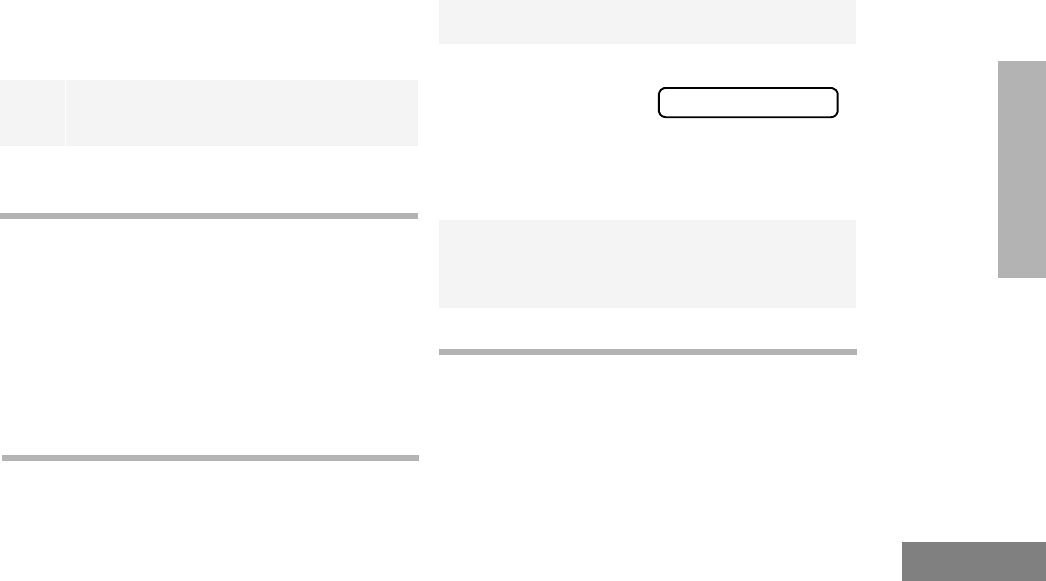
23
English
RADIO CALLS
Note: If the Radio Call List does not include
an alias for the radio ID, the ID displays.
Radios that do not support the signaling
protocol sound the alert tone, activate
the external alarm and display data.
CLEARING AN EMERGENCY
ALERT (
To clear an Emergency Alert:
Note: You must press an external switch to
clear the visible Emergency Alias and
display the next queued Emergency
Alias, if present. You must clear all
decoded Emergency Alerts before
encoding (sending) your own
Emergency Alert.
SENDING AN EMERGENCY
REMOTE MONITOR
As your radio responds to an Emergency Alert,
only the Emergency Queue menu is available.
To access the Emergency Queue menu:
1Press any button on the radio to
cancel the Emergency Alert tone.
2Press (or activate) an external
pushbutton or foot switch.
1u to enter Menu Mode.
2The radio displays
the list of aliases
currently in the
Emergency queue,
similar to that
shown, oldest to
newest.
3z or y to view the next oldest
Emergency Remote Monitor packet and to
choose the packet to send.
4Press the PTT to send the packet.
MDC CALL 01

24
English
RADIO CALLS
SENDING AN EMERGENCY ALERT E
A priority Emergency Alert can be sent to a
specific radio or dispatch center by pressing:
• A button preprogrammed by your dealer
(see pages 6 - 7)
• The footswitch
• A pushbutton accessory
Emergency Alerts have priority over all other
calls.
The E symbol will appear on the display when
your radio is in the Emergency Alert state.
An Emergency Alert can be programmed to:
•Show E and sound a tone
–or–
•Show E (Silent Emergency)
–or–
• Activate the enhanced keypad microphone
so that all activity can be transmitted (for a
predetermined amount of time). See your
dealer for more information.
To cancel the Emergency Alert, press and hold
down the Emergency button.
SELECTIVE RADIO INHIBIT
Your radio is equipped with a security feature
that can temporarily render the unit inoperative
when an inhibit signal is sent from the base
station.
This feature is commonly used to disable radios:
• In case of theft
• When your vehicle is being serviced
• For system control reasons
Note: When your radio has been disabled by
the base station, all controls will be
inoperative except for the On/Off
button. When the radio is powered up,
the display will
show:
REPEATER OR TALKAROUND J
MODE
Talkaround Mode enables you to communicate
with another radio when either:
• The repeater is not operating
–or–
• Your radio is out of the repeater’s range but
Radio Disabled
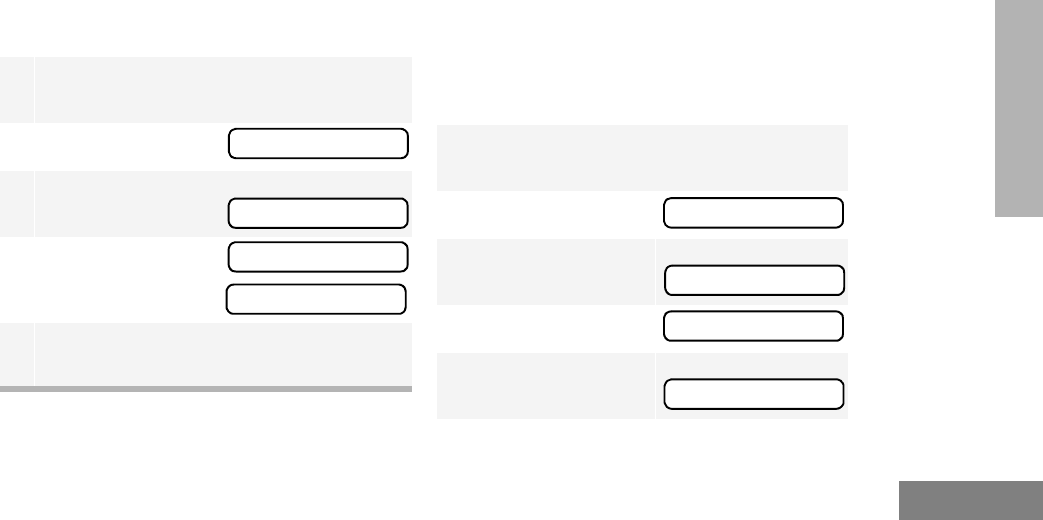
25
English
RADIO CALLS
within communicating distance of another
radio. The J symbol appears on the
display when Talkaround Mode is selected.
To select either Repeater Mode or Talkaround
Mode:
Press the preprogrammed Repeater/
Talkaround button (see page 6) to toggle
between Repeater Mode and Talkaround
Mode.
–or– (using the enhanced keypad microphone)
SETTING THE POWER LEVEL B
Each channel in your radio has a predefined
transmit power level that can be changed.
• High power ( S )
• Low power ( R )
You can set the power level in two ways:
Method 1
Press the preprogrammed Power Level button
(see page 6) to toggle between low and high.
–or–
Method 2 (using the keypad microphone)
1Press the Menu/Enter button to enter Menu
Mode.
2y or z until
3Press the Menu/
Enter button to select
4y or z until
or until
5Press the Menu/Enter button to confirm your
selection.
Rptr/Talkarnd
Rptr/Talkarnd
Repeater Mode
Talkarnd Mode
1Press the Menu/Enter button to enter Menu
Mode.
2y or z until
3Press the Menu/
Enter button to select
4y or z until
5Press the Menu/
Enter button to select
Utilities
Utilities
Power Level
Power Level
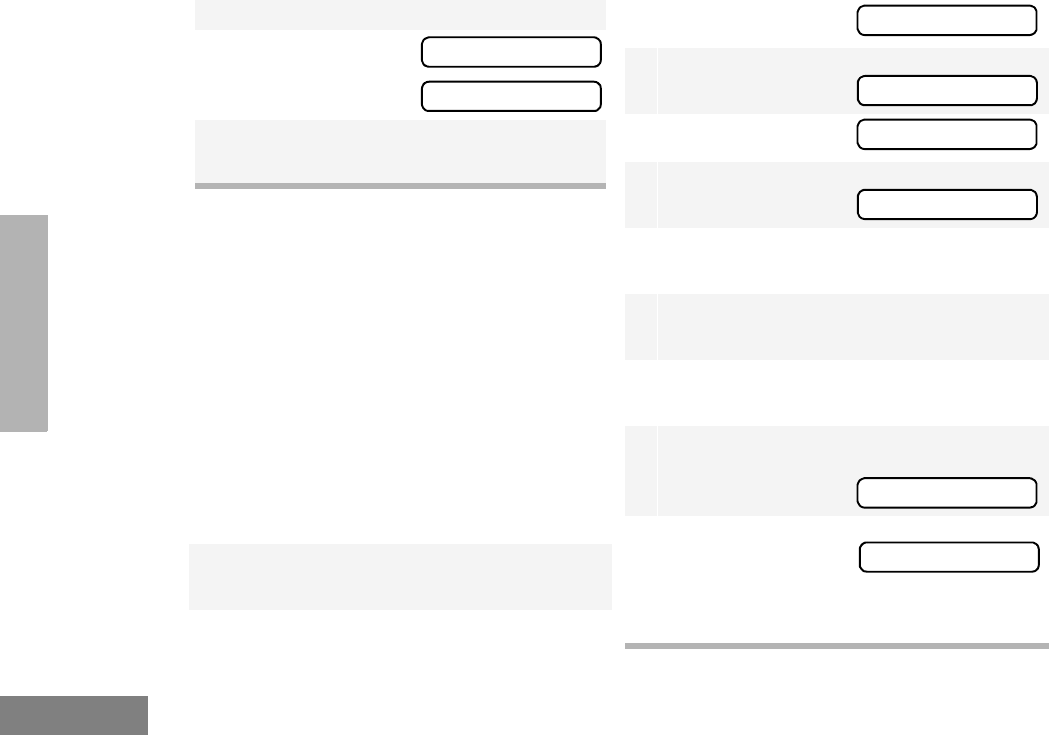
26
English
RADIO CALLS
NAME AND CALL TONE TAGGING
You can program your radio to sound a
particular alert tone when:
• a specific user is calling—name tone
tagging, or
• your radio is receiving a type of radio call—
call tone tagging.
There are seven alert tones to select from.
Note: The enhanced keypad microphone is
required to operate this feature.
To tag a specific user’s name or ID:
The display shows the current power level.
6y or z until
or until
7Press the Menu/Enter button to confirm the
selection.
1Press the Menu/Enter button to
enter Menu
Mode.
Power High?
Power Low?
2y or z until
3Press the Menu/Enter
button to select
4y or z until
5Press the Menu/Enter
button to select
6y or z until you see the name or call you
want to tag.
7Press the Menu/Enter button to confirm the
selection.
8y or z until you hear one of the seven
tones you want to use for this name or call.
9Press the Menu/Enter button to confirm the
selection.
You will see
10 Press the Exit button
to return to
–or–
Hold down the Exit button to exit Menu Mode.
Audio/Tones
Audio/Tones
Name Tone Tag
Name Tone Tag
Name Tag Set
Name Tone Tag
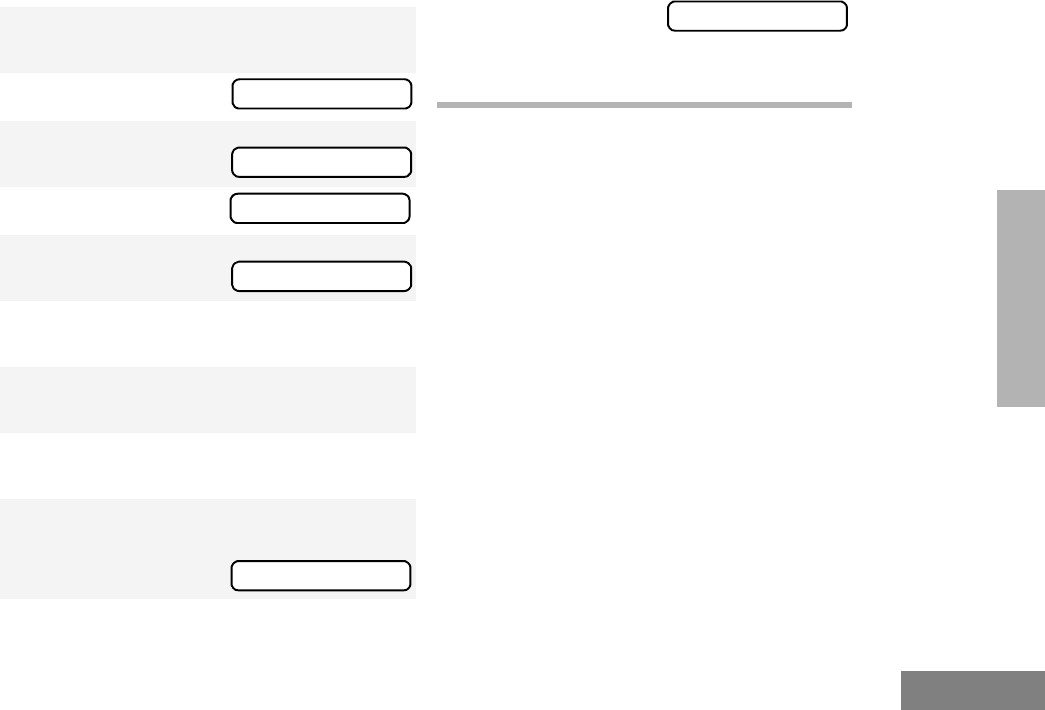
27
English
RADIO CALLS
To tag a type of radio call:
1Press the Menu/Enter button to enter Menu
Mode.
2y or z until
3Press the Menu/
Enter button to select
4y or z until
5Press the Menu/
Enter button to select
6y or z until you see the call type you
want to tag.
7Press the Menu/Enter button to confirm the
selection.
8y or z until you hear the tone you want
to use for this type of call.
9Press the Menu/Enter button to confirm the
selection.
You will see
Audio/Tones
Audio/Tones
Call Tone Tag
Call Tone Tag
Call Tag Set
10 Press the Exit button
to return to
–or–
Hold down the Exit button to exit Menu Mode.
Call Tone Tag

28
English
RADIO CALLS
Notes
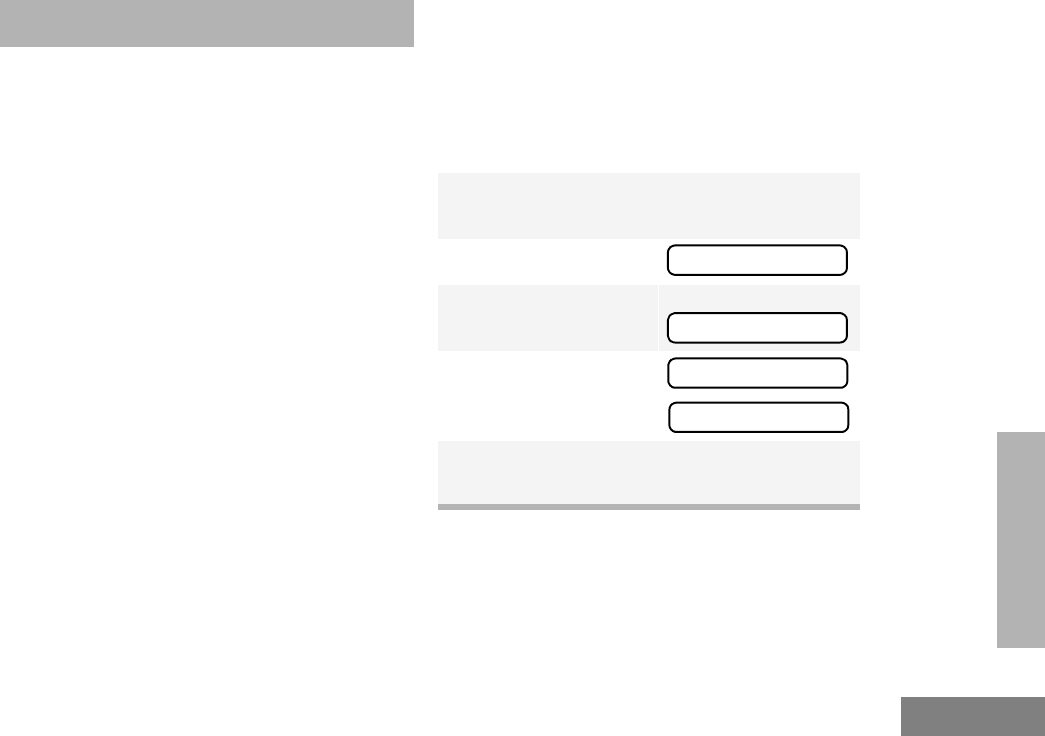
29
English
SCAN
SCAN
Your radio can monitor multiple channels in a
scan list. Your dealer can program up to 16
different channels into each scan list. When
your radio detects activity on a scan list
channel, it will automatically switch to that
channel.
Note: The same channels can be assigned to
different scan lists.
STARTING OR STOPPING SCAN G
The G symbol, and the number of the
channel you are transmitting on, will appear on
the display when you start a scan operation.
The green LED indicator blinks during a scan
operation and stops blinking when the radio
switches to a channel.
Note: If you enter Menu Mode while the radio
is scanning, scanning will stop. It will
resume when you exit Menu Mode.
You can start or stop a scan operation in one of
three ways:
Method 1
Press the preprogrammed Scan button (see
page 6) to start or stop scanning.
–or–
Method 2 (with the enhanced keypad
microphone)
–or–
Method 3
If programmed by your dealer, the radio will
start scanning when you select a channel that
has auto scan enabled.
1
Press the
Menu/Enter
button to
enter Menu
Mode.
2y or z until
3
Press the
Menu/Enter
button to
select
4y or z until
–or–
5
Press the
Menu/Enter
button to
confirm your
selection.
System Scan
System Scan
Sys Scan On?
Sys Scan Off?

30
English
SCAN
TALKBACK
The Talkback feature allows you to respond to a
transmission while scanning. If a transmission on
a channel is detected while scanning, the radio
will stop on that channel for a preprogrammed
period of time. During this “hangtime” you may
respond by pressing the PTT.
Note: If transmission stops/ceases or if the PTT
is not pressed for a preprogrammed
duration, the radio will continue scanning.
Also, the LED scan indicator stops
blinking while the radio is in hangtime.
DELETING A NUISANCE CHANNEL
If a channel continually generates unwanted
calls or noise (a “nuisance” channel), use the
Scan button to temporarily delete the channel
from the scan list.
Note:You cannot delete a priority channel (see
page 32) or the last remaining channel in
a scan list.
Restoring a Channel to the Scan List
To restore a previously deleted channel to the
scan list, restart the scan operation or turn your
radio off and on again.
EDITING A SCAN LIST
Note: The enhanced keypad microphone is
required to operate this feature.
A scan list is a group of up to 16 channels. Each
channel can have a scan list assigned to it. The
same channel can be included in several scan
lists, and the same scan list can be assigned to
several Channel Selector positions. For
example:
When you edit a scan list, you can either add,
delete, or prioritize channels. The K symbol will
appear on the display while you are in edit mode.
Note: Your radio cannot receive any calls while
you are editing a scan list.
1While the radio is on the nuisance channel, hold
down the Scan button until you hear a tone.
2Release the Scan button. The nuisance
channel is deleted.
Position 2 Position 14
C
h
a
n
n
e
l
s
11
32
53
611
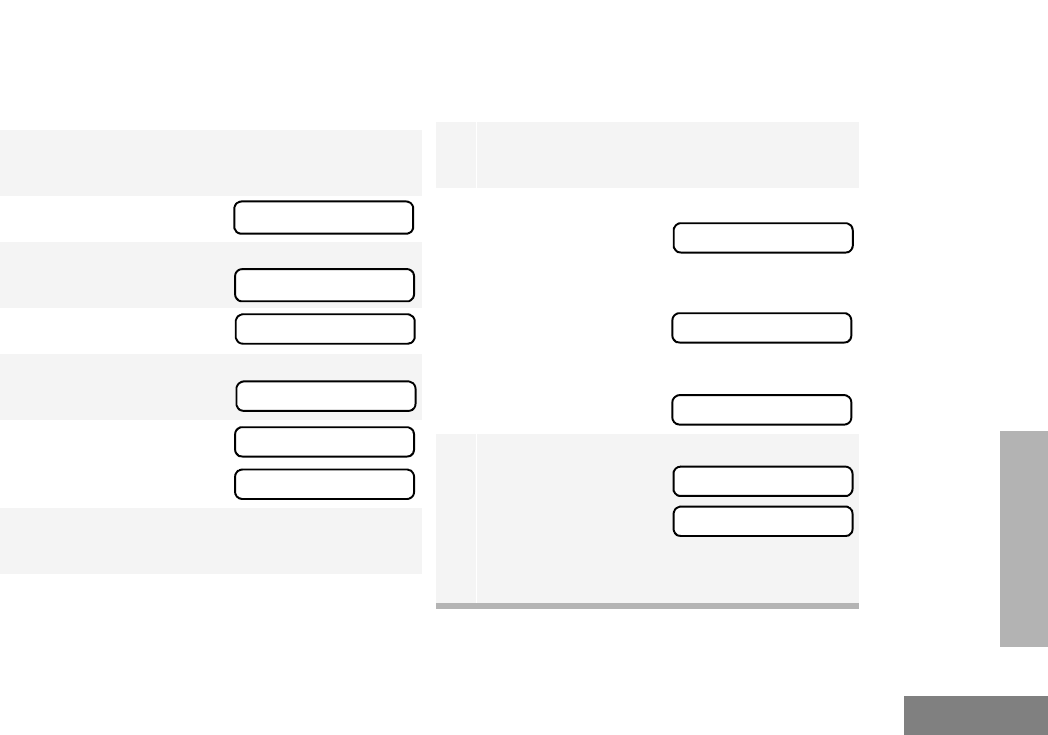
31
English
SCAN
Adding or Deleting Channels in a Scan List
Note: The enhanced keypad microphone is
required to operate this feature.
To add or delete channels in a scan list:
1
Press the
Menu/Enter
button to
enter Menu
Mode.
2y or z until
3
Press the
Menu/Enter
button to
select
4y or z until
5
Press the
Menu/Enter
button to
select
6y or z until
or until
7
Press the
Menu/Enter
button to
confirm your
selection.
Program Lists
Program Lists
Scan List
Scan List
Add Entry?
Delete Entry?
8y or z until you see the channel you
want to add or delete.
Note: You cannot delete the last remaining
channel in a scan list.
9
Press the
Menu/Enter
button to
confirm your
selection.
10 If you added a channel,
you will see
–or–
If you deleted a channel,
you will see
Press the
Menu/Enter
button to
confirm the
deletion.
You will see
11
Press the
Menu/Enter
button to
return to
or to return to
–or–
Hold down the Exit button to exit Menu Mode.
Entry Saved
Delete?
Entry Deleted
Add Entry?
Delete Entry?

32
English
SCAN
Prioritizing a Channel in a Scan List
Note: The enhanced keypad microphone is
required to operate this feature.
You may want to check the activity on one or
two channels more frequently than others. You
can do this by assigning them priority:
Note: Even if there may be activity on a non-
priority channel, your radio will
automatically switch to an active priority
channel and indicate the activity with a
short tone.
Setting Priority Channels
Note: You cannot reprioritize a Priority 1
channel to Priority 2.
Priority Channel
Scanning Sequence
None specified Ch1➠Ch2➠Ch3➠Ch4➠
Ch1
Channel 2
(Priority 1) Ch2➠Ch1➠Ch2➠Ch3➠
Ch2➠Ch4➠Ch2➠…Ch1
Channel 2
(Priority 1)
Channel 8
(Priority 2)
Ch2➠Ch1➠Ch8➠Ch3➠
Ch2➠Ch4➠Ch8➠…Ch1
1
Press the
Menu/Enter
button to
enter Menu
Mode.
2y or z until
3
Press the
Menu/
Enter
button to
select
4y or z until
5
Press the
Menu/
Enter
button to
select
6y or z until
7
Press the
Menu/
Enter
button to
select
8y or z until
or until
Program Lists
Program Lists
Scan List
Scan List
Edit Priority?
Edit Priority?
Priority #1?
Priority #2?
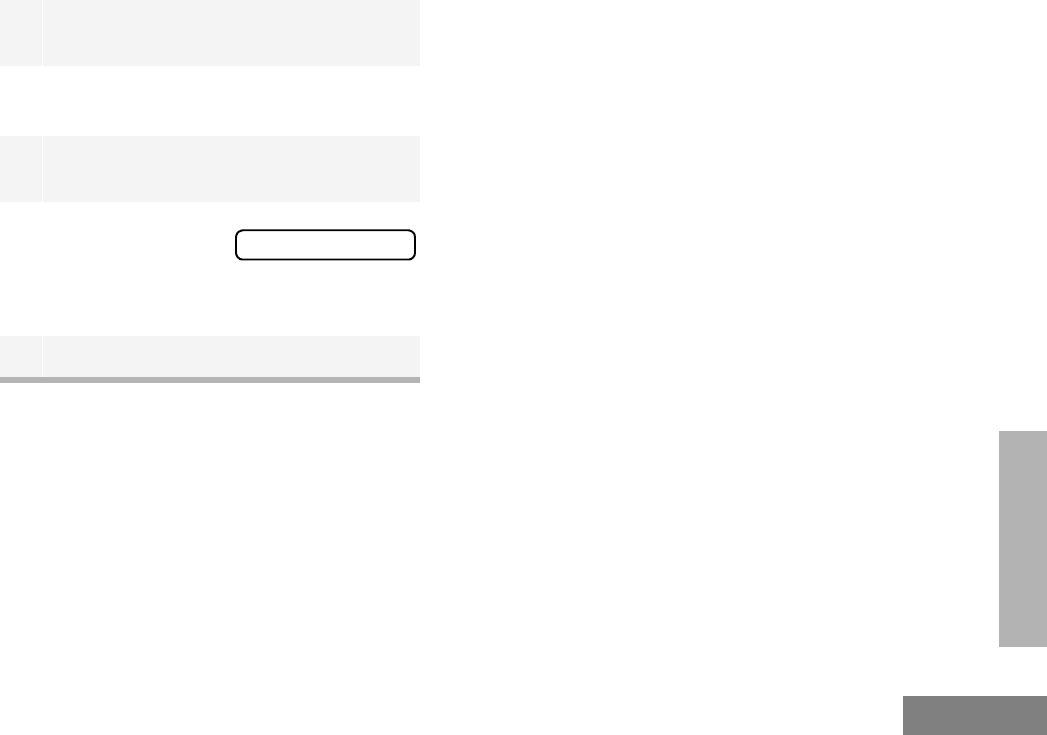
33
English
SCAN
Note: If you want to reprioritize all channels, you
must first delete each priority channel from
the scan list, and then addit back.
9
Press the
Menu/Enter
button to
select the
desired priority level.
10 y or z until you see the channel you
want to prioritize.
11
Press the
Menu/Enter
button to
prioritize that
channel.
12
Press the
Exit
button
to
return to
–or–
Hold down the Exit button to exit Menu Mode.
Edit Priority?

34
English
SCAN
Notes

35
English
PHONE
PHONE
If your radio has access to a telephone system,
you can make a phone call. To do this, your
radio must send an access code to a station
that connects it to a phone line. (Ask your dealer
for more details.) After completing a call, your
radio must send a deaccess code to hang up.
MAKING A PHONE CALL D
You can make a phone call using the
preprogrammed Phone button (see page 6) or
the radio menu. The D symbol appears on the
LCD screen when you are in Phone Mode.
To initiate a phone call:
Press the Phone button.
–or–
Do the following (an enhanced keypad
microphone is required):
1Switch to the desired channel.
2
Press the
Menu/Enter
button to
enter Menu
Mode.
3y or z until
4
Press the
Exit
button
to
select
5You will hear a series of tones indicating that an
access code is being sent automatically. You
will also see your access code displayed;
–or–
when using the enhanced keypad microphone
only, enter your access code using the keypad.
Phone
Phone

36
English
PHONE
6When you hear a dial tone, enter or select a
phone number:
y or z to select a number from the phone list;
–or–
when using the enhanced keypad microphone
only, enter the phone number using the keypad;
–or–
when using the enhanced keypad microphone
only,
a Press and release the preprogrammed
Speed Dial button (see page 7) to use the
Speed Dial feature.
b Press the key (1 to 8) corresponding to the
number you want to call,
–or-
press “0” if you want to call the last number
dialed.
Note: To redial the last number dialed (if not
using Speed Dial), do not choose a
number. Proceed to step 7.
Alternatively, if you entered your access
code using the keypad, press z once
to access the last number dialed; then
press and release the PTT.
7To end a phone call, do one of the following:
If your radio has the deaccess code
preprogrammed, proceed to step 8.
–or–
Enter the deaccess code using the keypad.
8Press the Phone button to exit Phone Mode.
–or–
Press the
Exit
button to
exit Phone Mode
and return to
–or–
Hold down
the
Exit
button to
exit Menu Mode.
Phone
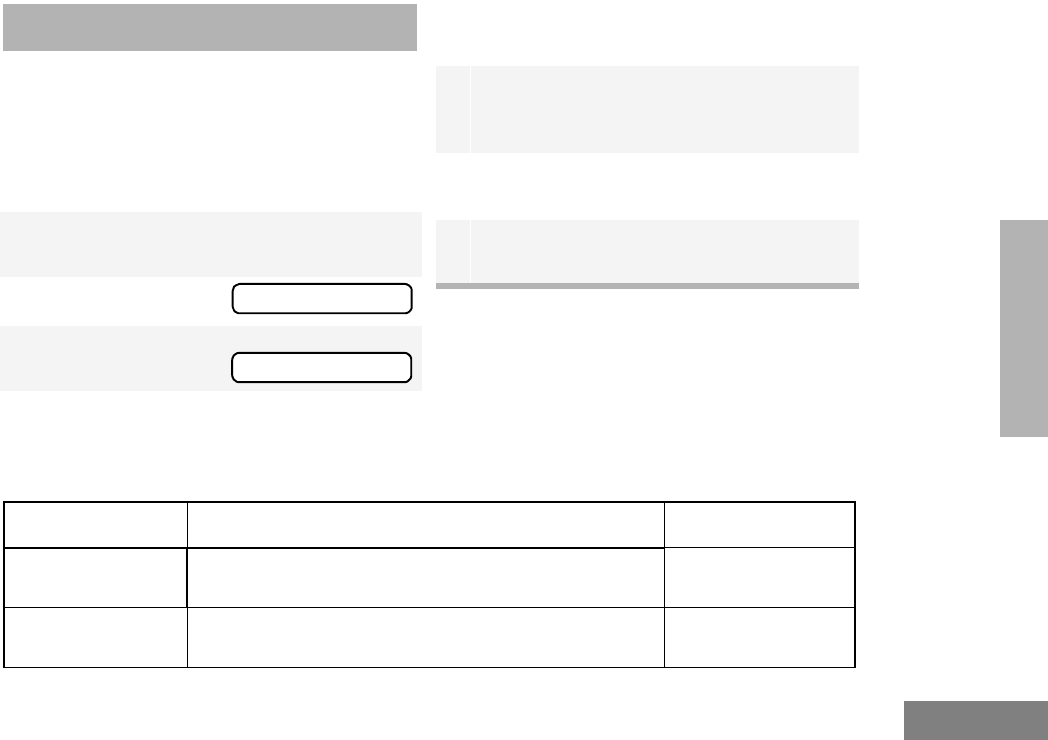
37
English
AUDIO/TONE
SETTINGS
AUDIO/TONE SETTINGS
You can customize the audio and tone feature
settings on your radio.
Note: The enhanced keypad microphone is
required to use this feature.
1
Press the
Menu/Enter
button to
enter Menu
Mode.
2y or z until
3
Press the
Menu/Enter
button to
select
Audio/Tones
Audio/Tones
4y or z until you see the feature you want to
change. (See the table below.)
5
Press the
Menu/Enter
button to
select the
feature. You will see the feature’s current
setting.
6y or z for available settings. (See the table
below.)
7
Press the
Menu/Enter
button to
select the
desired setting.
Audio/Tone Settings
Feature What it Does Settings
Alert Vol Lvl Allows the volume level of the audio and the volume level
of the alert tones to be set independently.
Ind Alert Off
Ind Alert On
Tone Disable Turns all tones on or off. Tones On
Tones Off
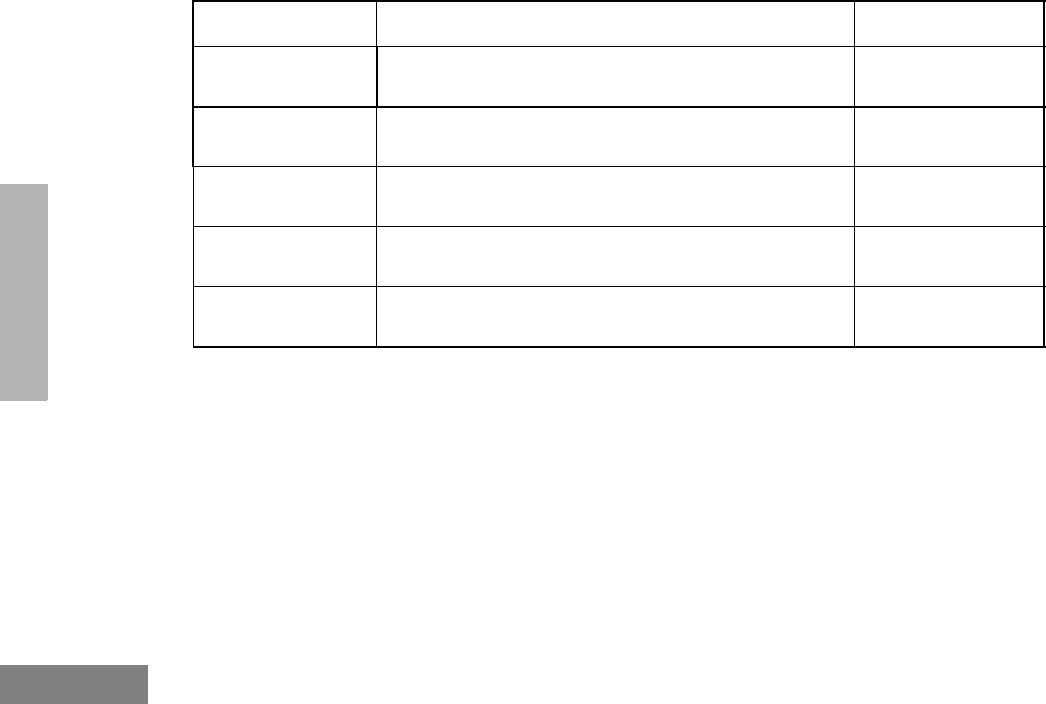
38
English
AUDIO/TONE
SETTINGS
Name Tone Tag Assigns a specific tone to all calls from a specific user
(see page 26 for details).
Standard
Alert #1 – #7
Call Tone Tag Assigns a specific tone when receiving a specific type of
radio call (see page 27 for details).
Standard
Alert #1 – #7
Escalert Gradually increases the volume of the alarm tones when
a call is not answered.
Escalert On
Escalert Off
Companding
(XPand™) Approximates the same audio quality for 12.5kHz
channels to that of 25kHz channels.
Compand On
Compand Off
Keypad Tones Turns keypad tones on or off. Tones On
Tones Off
Audio/Tone Settings
Feature What it Does Settings
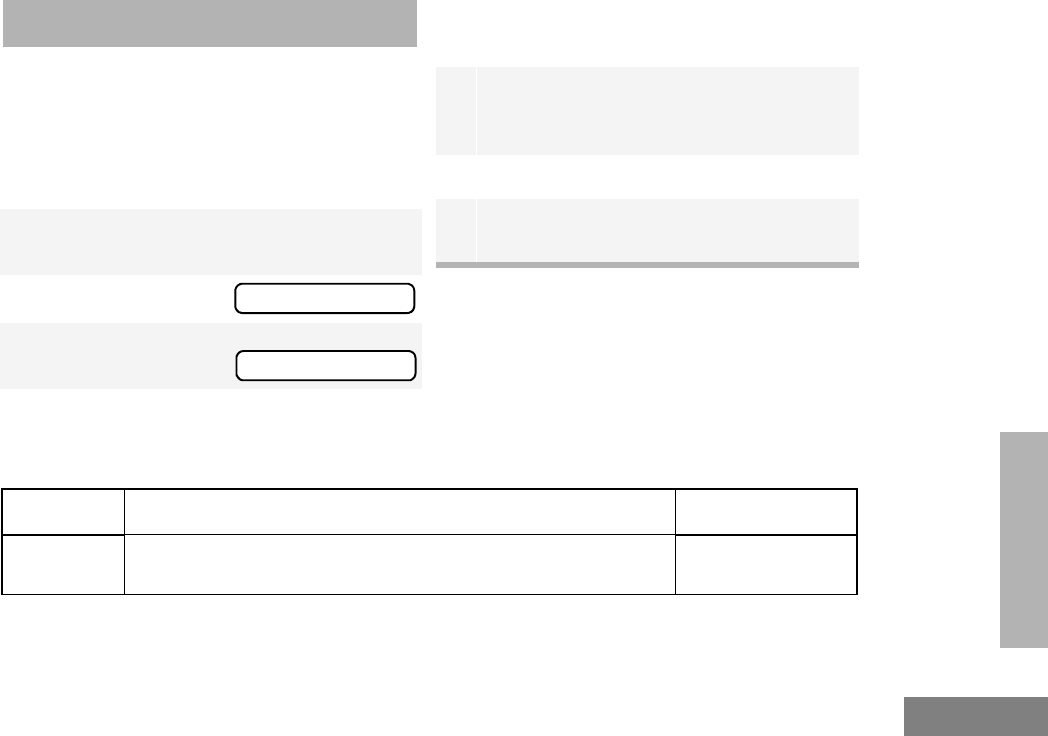
39
English
UTILITIES
UTILITIES
You can customize some of your radio’s
features.
Note: The enhanced keypad microphone is
required to access this feature.
1
Press the
Menu/Enter
button to
enter Menu
Mode.
2y or z until
3
Press the
Menu/Enter
button to
select
Utilities
Utilities
4y or z until you see the feature you want
to change (see table below).
5
Press the
Menu/Enter
button to
select the
feature. You will see the feature’s current
setting.
6y or z for available settings.
7
Press the
Menu/Enter
button to
select the
desired setting.
Utilities Features
Feature What it Does Settings
Power
Level
Changes the power level of the radio to high or low (see page 25). Power High
Power Low
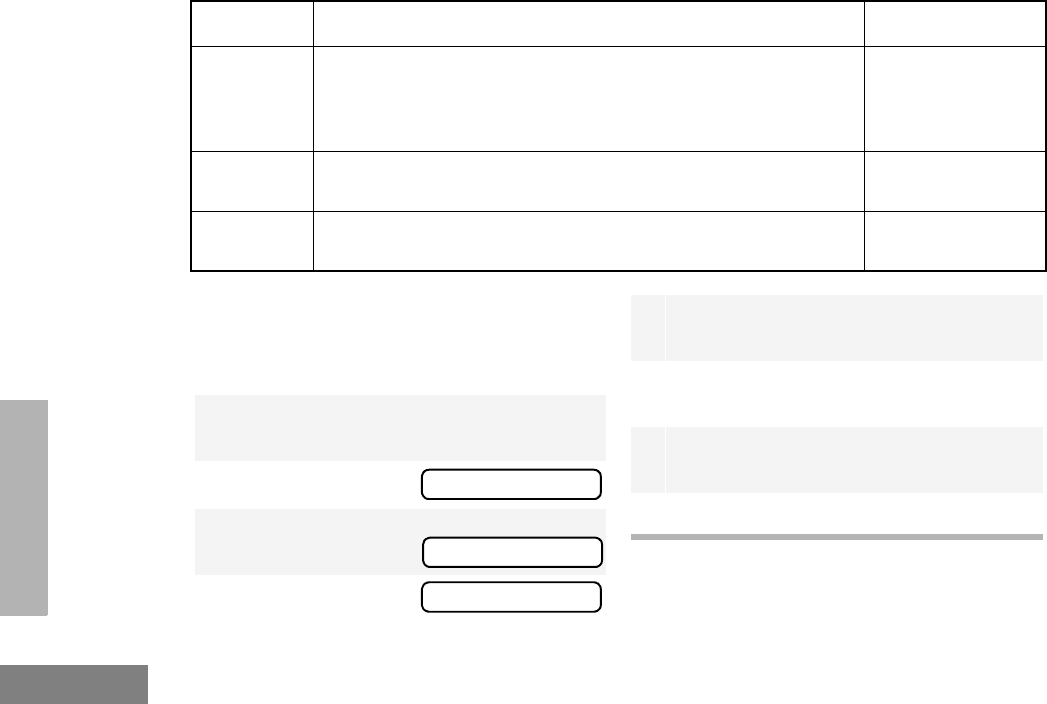
40
English
UTILITIES
SELECTING THE DISPLAY
LANGUAGE
To select the display language:
Language
Selection
Allows you to select the language displayed on the display. English
Spanish
Portuguese
French
Option
board
Activates/deactivates the option board installed in your radio. Opt Board On
Opt Board Off
Software
Ver #
Displays the radio’s software version number. ——
Utilities Features
Feature What it Does Settings
1
Press the
Menu/Enter
button to
enter Menu
Mode.
2y or z until
3
Press the
Menu/
Enter
button to
select
4y or z until
Utilities
Utilities
Language Selct
5
Press the
Menu/Enter
button to
confirm your
selection.
6y or z until desired language is
displayed.
7
Press the
Menu/Enter
button to
select desired
language.
8Hold down
the
Exit
button to
exit the menu.

41
English
WARRANTY
WARRANTY
LIMITED WARRANTY
MOTOROLA COMMUNICATION PRODUCTS
I. WHAT THIS WARRANTY COVERS AND
FOR HOW LONG:
MOTOROLA INC. (“MOTOROLA”) warrants the
MOTOROLA manufactured Communication
Products listed below (“Product”) against defects
in material and workmanship under normal use
and service for a period of time from the date of
purchase as scheduled below:
CDM1250 Mobile Units Two (2) Years
Product Accessories One (1) Year
Motorola, at its option, will at no charge either
repair the Product (with new or reconditioned
parts), replace it (with a new or reconditioned
Product), or refund the purchase price of the
Product during the warranty period provided it is
returned in accordance with the terms of this
warranty. Replaced parts or boards are
warranted for the balance of the original
applicable warranty period. All replaced parts of
Product shall become the property of
MOTOROLA.
This express limited warranty is extended by
MOTOROLA to the original end user purchaser
only and is not assignable or transferable to any
other party. This is the complete warranty for the
Product manufactured by MOTOROLA.
MOTOROLA assumes no obligations or liability
for additions or modifications to this warranty
unless made in writing and signed by an officer
of MOTOROLA. Unless made in a separate
agreement between MOTOROLA and the
original end user purchaser, MOTOROLA does
not warrant the installation, maintenance or
service of the Product.
MOTOROLA cannot be responsible in any way
for any ancillary equipment not furnished by
MOTOROLA which is attached to or used in
connection with the Product, or for operation of
the Product with any ancillary equipment, and all
such equipment is expressly excluded from this
warranty. Because each system which may use
the Product is unique, MOTOROLA disclaims
liability for range, coverage, or operation of the
system as a whole under this warranty.

42
English
WARRANTY
II. GENERAL PROVISIONS:
This warranty sets forth the full extent of
MOTOROLA’s responsibilities regarding the
Product. Repair, replacement or refund of the
purchase price, at MOTOROLA’s option, is the
exclusive remedy. THIS WARRANTY IS GIVEN
IN LIEU OF ALL OTHER EXPRESS
WARRANTIES. IMPLIED WARRANTIES,
INCLUDING WITHOUT LIMITATION, IMPLIED
WARRANTIES OF MERCHANTABILITY AND
FITNESS FOR A PARTICULAR PURPOSE,
ARE LIMITED TO THE DURATION OF THIS
LIMITED WARRANTY. IN NO EVENT SHALL
MOTOROLA BE LIABLE FOR DAMAGES IN
EXCESS OF THE PURCHASE PRICE OF THE
PRODUCT, FOR ANY LOSS OF USE, LOSS OF
TIME, INCONVENIENCE, COMMERCIAL
LOSS, LOST PROFITS OR SAVINGS OR
OTHER INCIDENTAL, SPECIAL OR
CONSEQUENTIAL DAMAGES ARISING OUT
OF THE USE OR INABILITY TO USE SUCH
PRODUCT, TO THE FULL EXTENT SUCH MAY
BE DISCLAIMED BY LAW.
III. STATE LAW RIGHTS:
SOME STATES DO NOT ALLOW THE
EXCLUSION OR LIMITATION OF INCIDENTAL
OR CONSEQUENTIAL DAMAGES OR
LIMITATION ON HOW LONG AN IMPLIED
WARRANTY LASTS, SO THE ABOVE
LIMITATION OR EXCLUSIONS MAY NOT
APPLY.
This warranty gives specific legal rights, and
there may be other rights which may vary from
state to state.
IV. HOW TO GET WARRANTY SERVICE:
You must provide proof of purchase (bearing the
date of purchase and Product item serial number)
in order to receive warranty service and, also,
deliver or send the Product item, transportation
and insurance prepaid, to an authorized warranty
service location. Warranty service will be
provided by Motorola through one of its
authorized warranty service locations. If you first
contact the company which sold you the Product
(e.g., dealer or communication service provider),
it can facilitate your obtaining warranty service.
You can also call Motorola at 1-800-927-2744
US/Canada.

43
English
WARRANTY
V. WHAT THIS WARRANTY DOES NOT
COVER:
A Defects or damage resulting from use of the
Product in other than its normal and
customary manner.
B Defects or damage from misuse, accident,
water, or neglect.
C Defects or damage from improper testing,
operation, maintenance, installation,
alteration, modification, or adjustment.
D Breakage or damage to antennas unless
caused directly by defects in material
workmanship.
E A Product subjected to unauthorized
Product modifications, disassemblies or
repairs (including, without limitation, the
addition to the Product of non-Motorola
supplied equipment) which adversely affect
performance of the Product or interfere with
Motorola’s normal warranty inspection and
testing of the Product to verify any warranty
claim.
F Product which has had the serial number
removed or made illegible.
G Freight costs to the repair depot.
H A Product which, due to illegal or
unauthorized alteration of the software/
firmware in the Product, does not function in
accordance with MOTOROLA’s published
specifications or the FCC type acceptance
labeling in effect for the Product at the time
the Product was initially distributed from
MOTOROLA.
I Scratches or other cosmetic damage to
Product surfaces that does not affect the
operation of the Product.
J Normal and customary wear and tear.
VI.PATENT AND SOFTWARE PROVISIONS:
MOTOROLA will defend, at its own expense, any
suit brought against the end user purchaser to
the extent that it is based on a claim that the
Product or parts infringe a United States patent,
and MOTOROLA will pay those costs and
damages finally awarded against the end user
purchaser in any such suit which are attributable
to any such claim, but such defense and
payments are conditioned on the following:
A that MOTOROLA will be notified promptly in
writing by such purchaser of any notice of
such claim;
B that MOTOROLA will have sole control of
the defense of such suit and all negotiations

44
English
WARRANTY
for its settlement or compromise; and
C should the Product or parts become, or in
MOTOROLA’s opinion be likely to become,
the subject of a claim of infringement of a
United States patent, that such purchaser
will permit MOTOROLA, at its option and
expense, either to procure for such
purchaser the right to continue using the
Product or parts or to replace or modify the
same so that it becomes non-infringing or to
grant such purchaser a credit for the Product
or parts as depreciated and accept its return.
The depreciation will be an equal amount
per year over the lifetime of the Product or
parts as established by MOTOROLA.
MOTOROLA will have no liability with respect to
any claim of patent infringement which is based
upon the combination of the Product or parts
furnished hereunder with software, apparatus or
devices not furnished by MOTOROLA, nor will
MOTOROLA have any liability for the use of
ancillary equipment or software not furnished by
MOTOROLA which is attached to or used in
connection with the Product. The foregoing
states the entire liability of MOTOROLA with
respect to infringement of patents by the Product
or any parts thereof.
Laws in the United States and other countries
preserve for MOTOROLA certain exclusive
rights for copyrighted MOTOROLA software
such as the exclusive rights to reproduce in
copies and distribute copies of such Motorola
software. MOTOROLA software may be used in
only the Product in which the software was
originally embodied and such software in such
Product may not be replaced, copied,
distributed, modified in any way, or used to
produce any derivative thereof. No other use
including, without limitation, alteration,
modification, reproduction, distribution, or
reverse engineering of such MOTOROLA
software or exercise of rights in such
MOTOROLA software is permitted. No license is
granted by implication, estoppel or otherwise
under MOTOROLA patent rights or copyrights.
VII.GOVERNING LAW:
This Warranty is governed by the laws of the
State of Illinois, USA.
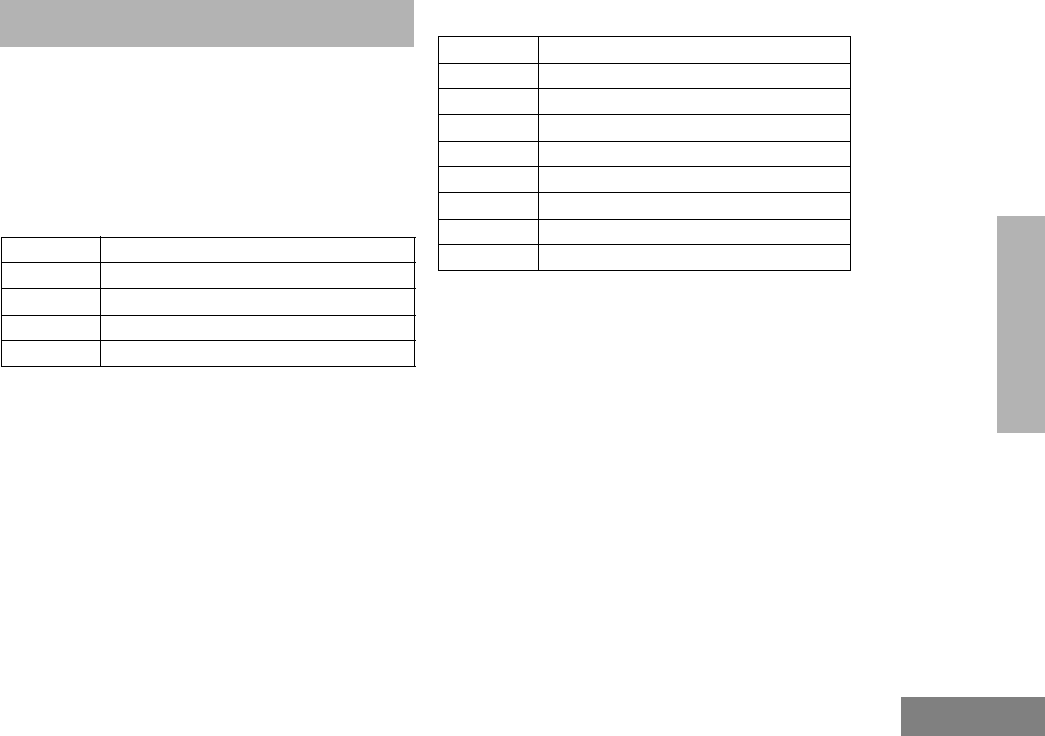
45
English
ACCESSORIES
ACCESSORIES
Motorola offers a number of accessories to
enhance the productivity of your two-way
radio. Many of the available accessories are
listed below. For a complete list, see your
Motorola dealer.
AUDIO
MOUNTING
RMN4025 Compact Remote Speaker Microphone
RMN4026 Enhanced Keypad Microphone
RMN4038 Heavy Duty Microphone
RSN4001 External Speaker 13W
HSN8145 External Speaker 7.5W
GLN7324 Low Profile Trunnion
RLN4780 High Profile Trunnion
HLN8097 Removable Slide Mount
RLN4779 Key Lock Mount
RLN4774 3 Point Lowband Mount
RLN4782 DIN Mounting Kit (in dash)
RKN4077 Remote Mount Cable - 3 m
RKN4078 Remote Mount Cable - 5 m
RKN4079 Remote Mount Cable - 7 m
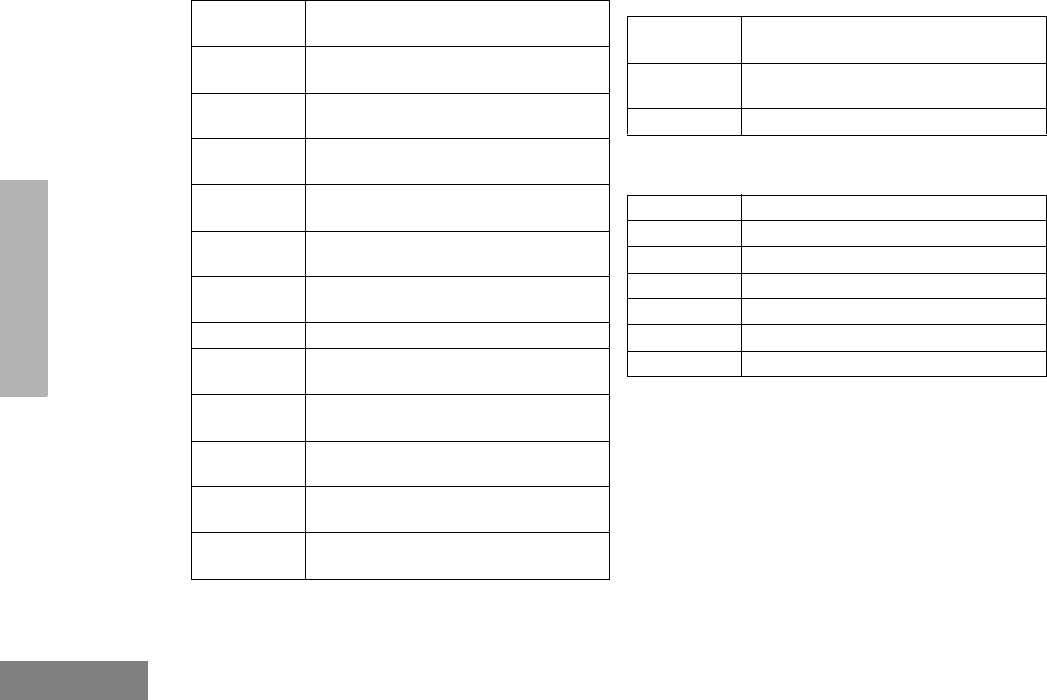
46
English
ACCESSORIES
ANTENNAS
CONTROL STATION
Note: A variety of interchangeable buttons
are available for use in the P1-P4
locations on your radio (page 3). See
your dealer for further details.
RAB4002ARB Lowband 29.7-36 MHz, 1/4 Wave Base
Load
RAB4003ARB Lowband 36-42 MHz, 1/4 Wave Base
Load
RAB4004ARB Lowband 42-52 MHz, 1/4 Wave Base
Load
HAD4006A VHF 136-144 MHz, 1/4 Wave Roof
Mount
HAD4007A VHF 146-150.8 MHz, 1/4 Wave Roof
Mount
HAD4008A VHF 150.8-162 MHz, 1/4 Wave Roof
Mount
HAD4009A VHF 162-174 MHz, 1/4 Wave Roof
Mount
HAD4014A VHF 146-172 MHz, 3dB Gain Roof Mount
HAE4002A UHF 403-430 MHz, 1/4 Wave Roof
Mount
HAE4003A UHF 450-470 MHz, 1/4 Wave Roof
Mount
HAE4010A UHF 406-420 MHz, 3.5dB Gain Roof
Mount
HAE4011A UHF 450-470 MHz, 3.5dB Gain Roof
Mount
HAE4019A UHF 450-470 MHz, 5dB Gain Roof
Mount
HAE4004A UHF 470-512 MHz, 1/4 Wave Roof
Mount
HAE4012A UHF 470-494 MHz, 3.5dB Gain Roof
Mount
09-02105F01 BNC Connector
GPN6145 Desktop Power Supply 1-25W (EMC)
HPN4002 Desktop Power Supply 1-25W
GPN6149 Desktop Power Supply 25-45W (EMC)
HPN4001 Desktop Power Supply 25-45W
RMN4030 Desktop Microphone
GLN7318 Desktop Tray without Speaker
GLN7326 Desktop Tray with Speaker
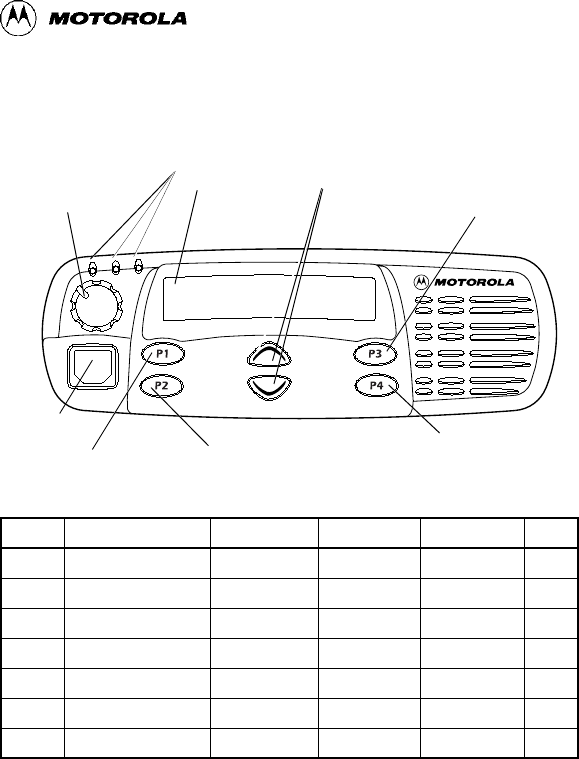
Sending a Call
1. Turn radio on and select appropriate zone and channel.
2. Press
PTT
, hold the microphone 1 to 2 inches (2.5 to 5 cm) from your mouth,
and speak clearly into it.
3. Release
PTT
to listen.
Receiving a Call
1. Turn radio on and adjust volume to the desired level.
2. Select desired channel.
3. To respond to an incoming call, press
PTT
, hold the microphone 1 to 2 inches
(2.5 to 5 cm) from your mouth, and speak clearly into it.
Deleting a Nuisance Channel During Scanning
1. While radio is on a nuisance channel, hold down preprogrammed
Scan
button
until you hear a tone.
2. Release
Scan
button.
Making a Phone Call
1. Press
Phone
button, or select
Phone
from the menu.
2. If access code is not displayed, send access code if required.
3. Send phone number in one of the following ways:
• Press and release
PTT
to send last dialed number.
—or—
• when using enhanced keypad microphone only, press preprogrammed
Speed Dial
button, followed by a keypad key (1–8), to access first nine num-
bers in your phone list. (Press
PTT
if buffered dial.)
—or—
• when using enhanced keypad microphone only, enter phone number using
the keypad. (Press
PTT
if buffered dial.)
4. Press
PTT
, hold the microphone 1 to 2 inches (2.5 to 5 cm) from your mouth,
and speak clearly into it.
Ending a Phone Call
1. Send deaccess code if required.
2. Press preprogrammed
Phone
button, or press the
Exit
key.
Sending and Cancelling an Emergency Alert
• To activate Emergency Alert, press preprogrammed
Emergency
button or
footswitch.
• To cancel, press and hold down
Emergency
button.
CDM1250™ Quick Reference Card
Record the functions for your radio’s programmable buttons in the table
provided below. For further information, see page 6 of this User Guide.
MAEPF 26782 O
(Interchangeable)
Programmable
Button 2 (P2) (Interchangeable)
Programmable
Button 4 (P4)
(Interchangeable)
Programmable
Button 3 (P3)
LCD Screen
Red/Yellow/Green
LED Indicators (Up/Down)
(Interchangeable)
Programmable
Button 1 (P1)
Channel Selector
Microphone
Jack
Knob
On/Off/Volume
Button Function Short Press Long Press Hold Down Page
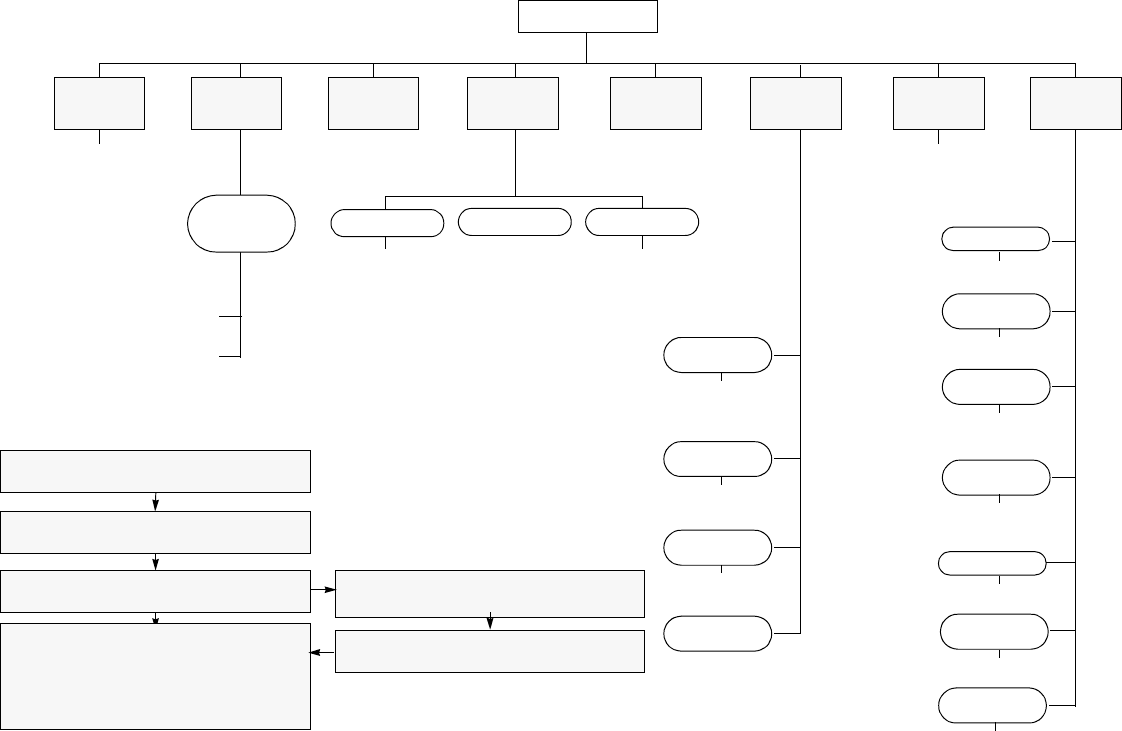
Selective Call
yz
high/low
Menu Navigation
Menu/Enter
on/off
add/delete
entry
repeater mode/
talkarnd mode
Press the Menu/Enter button to
enter Menu Mode.
y or zto scroll through the list.
Press the Menu/Enter button to select
Menu item.
Press the Exit button to return to
previous menu level
—or—
Hold down the Exit button to exit
Menu Mode.
y or zto scroll through
sub-list.
Press the Menu/Enter button to select
sub-menu item.
Menu Navigation Chart
(Refer to Menu Navigation guidelines—
lower, left-hand corner of this page)
edit
priority
select/
enter ID
Audio/
Tones
(p. 37)
Rptr/
Talkarnd
(p. 24)
Utilities
(p. 39)
Zone
(p. 12)
Radio
Call
(p. 16)
Phone
(p. 35)
Program
Lists
System
Scan
(p. 29)
yzyz
Scan List
(p. 30)
yy yz yz yz
Call Alert Radio Check
select/
enter ID select/
enter ID
Power
Level
select
Language
Select
on/off
Option
Board
Software
Ver #
on/off
Alert Vol Lvl
on/off
Tone
Disable
standard/alert
#1 - #7
Name Tone
Tag
Call Tone
Tag
standard/alert
#1 - #7
Escalert
on/off
Companding
on/off
Keypad
Tones
on/off